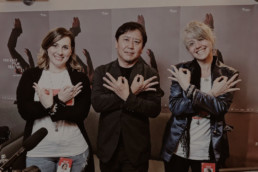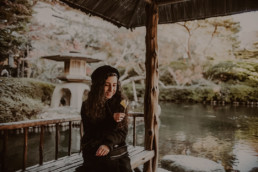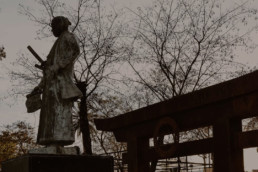Bringing Japan to Italy: episode 04 – Takeuchi Hideki
In occasione del Far East Film Festival, abbiamo avuto l'onore e il piacere di poter intervistare Takeuchi Hideki, regista di "Fly me to the Saitama" (翔んで埼玉 - Tonde Saitama), presentato in Italia durante il festival per la sua premiere europea!
Takeuchi Hideki ha esordito lavorando per Fuji Television e nel 1996 ha diretto la prima delle sue serie per questa emittente. Nel 1998 ha vinto il premio come miglior regista ai Television Drama Academy Awards per "Just a Little More, God" ma i riconoscimenti ricevuti non si fermano qui.
Il suo debutto nei lungometraggi arriva nel 2009 con la commedia musicale drammatica in due parti Nodame Cantabile. Takeuchi Hideki continua ad alternarsi fra grande e piccolo schermo con Thermae Romae e due serie televisive, passando con molta disinvoltura dal dramma storico alla commedia brillante.
Thermae Romae ha ottenuto un successo talmente clamoroso nei botteghini giapponesi che Takeuchi-san ne è ha realizzato il sequel, Thermae Romae II, uscito il 26 aprile 2014 e presentato in anteprima dopo una settimana al 16° Far East Film Festival di Udine in Italia.
Quest'anno, il regista è tornato al Far East Film Festival con "Fly me to the Saitama", commedia brillante e un po' surreale sul campanilismo che vige fra Saitama e Tokyo, con protagonisti il cantante e attore GACKT-san e l'attrice Fumi Nikaido, supportati ad altri nomi famosi all'interno del cast. Fly me to the Saitama ha anche vinto il premio MyMovies.com come migliore film acclamato dal pubblico.
Quella con Takeuchi-san è stata un'intervista interessante e divertente che racconta i retroscena del film, curiosità e prospettive per la collaborazione futura fra Italia e Giappone. Vi auguriamo buona visione e siamo curiosi di sapere il vostro feedback!
Bringing Japan to Italy: episode 03 – RIADO space design
Durante la Milano Design Week abbiamo avuto il piacere di assistere ad una mostra davvero particolare e anche il piacere di intervistare due artiste giapponesi presenti nella capitale lombarda. Stiamo parlando di Sachiko Hiroiuchi, interiro designer presso RIADO space design, ed Ayumi Shima, designer di stoffe direttamente dal Giappone.
Nata a Fukui, in Giappone, Sachiko Hiroiuchi vive e lavora a Osaka dove nel suo studio RIADO si focalizza sulla progettazione per negozi, ristoranti, uffici, appartamenti, e nel campo dell'interior industrial design. La sua attività è incentrata nella progettazione di mobili, illuminazione e complementi di arredo.
Al suo lato da progettista affianca un'attività di ricerca sui materiali dove opera con grande sensibilità nel campo artistico. Ed è proprio qui che sviluppa temi sulla carta della materia prima "Kozo", "Mitsumata" e "Gampi " con tematiche incentrate sull'artigianato tradizionale giapponese dove ogni opera è realizzata con molta cura.
Le texture che vedrete nel video sono opera di Ayumi Shima, artista e textile designer giapponese, nata a Kyoto, in Giappone, dove vive e lavora.
Specializzata nel campo di textile design sviluppa temi artistici con ricerche specifiche nel campo artistico pittorico. Suo interesse particolare è il colore legato alla materia tessile e le sue opere sono caratterizzate da variazioni di colori e trasparenze legati alla materia.
Nel suo bagaglio artistico non dimentica la sua tradizione e, attratta da tecniche più antiche come la stampa giapponese, Ayumi opera con grande sensibilità con riferimenti alla natura come la luce naturale, i fiori, gli alberi, la foresta.
Sunbeams Leaves
Con questa mostra “SUNBEAMS LEAVES” le autrici Sachiko Horiuchi e Ayumi Shima propongono un'installazione che vede protagonisti la carta e il tessuto nell'interpretazione delle quattro stagioni.
Creando un percorso che accompagna il visitatore nell'esplorare le trasparenze dettate dal "raggio di luce" sui materiali, i protagonisti di questa mostra sono la carta tradizionale giapponese e i delicati tessuti colorati. Questi materiali danzano insieme alla luce che viene filtrata trasmettendo il colore del cielo, dell'acqua, della terra, ma anche il colore della foresta e della natura dove la luce è protagonista.
La mostra avvenuta presso AD GALLERY si focalizza sul tema di luce e colore proponendo una serie di opere frutto di un lungo lavoro di ricerca delle artiste.
Ora vi lasciamo alla nostra intervista video e siamo curiosi di sapere il vostro feedback! Enjoy the show!
Bringing Japan to Italy: episode 02 – Masami Suda
Eccoci con il secondo appuntamento della nostra serie Bringing Japan to Italy, dove intervistiamo personaggi che aiutano a divulgare la cultura giapponese in Italia e nel mondo.
Dopo il grande successo del primo episodio dedicato ad Alberto moro, oggi condividiamo con voi la nostra chiacchierata con Masami Suda, character designer di moltissimi anime fra cui Hokuto no Ken (Kenshiro), dr Slump e Arale, Yo-Kai Watch, Mach Go Go Go, Candy Candy, Kagaku Ninjatai Gatchaman F, Ai Shite Knight (Kiss me Licia) e molti altri lavori che hanno segnato l'infanzia di tanti ormai adulti nel mondo.
Vi auguriamo una buona visione e siamo curiosi di sentire i vostri commenti!
Bringing Japan to Italy: episode 01 - Alberto Moro
Eccoci con il primo episodio della nostra nuova serie 『Bringing Japan to Italy』dedicato ad Alberto Moro, presidente dell'associazione Giappone in Italia.
Qualche settimana fa lo abbiamo incontrato durante il finissage della sua mostra "Il mio Giappone" che, come lui definisce, è un grande atto d'amore nei confronti di questa nazione, della cultura e del popolo Giapponese.
Con questo primo video, lanciamo la nostra nuova serie dedicata a tutti quei personaggi che promuovono la cultura giapponese e il mondo del Giappone nella nostra nazione. Japan Italy Bridge, si vuole far promotore ancora più a fondo di questo Paese, delle sue aziende e di tutto il mondo dedicato alla nazione del Sol Levante.
Buona visione
Japan Italy: Prossima fermata: Giappone! Intervista a Stefania Sabia
"Un Italiana in Giappone" la serie - Stefania Sabia
La fratellanza fra Italia e Giappone negli ultimi anni è diventata sempre più stretta e solidale. Non è raro infatti trovare nostri connazionali che desiderano spostarsi nella terra del Sol Levante, tuttavia in pochi riescono a realizzare questo sogno. Oggi vogliamo condividere con voi l’esperienza di Stefania Sabia, italianissima ragazza che da circa due anni vive e lavora in Giappone!
JIB: Ciao Stefania, innanzitutto grazie per aver accettato di tenere questa intervista con noi.
S: Grazie a voi per avermi contattata e aver pensato al mio blog!

JIB: Raccontaci un po’ di te e di cosa fai nella vita
S: Mi chiamo Stefania, sono laureata in lingua e letteratura giapponese e da circa 2 anni vivo e lavoro in Giappone, a Tokyo.
Sono la creatrice del blog Prossima Fermata Giappone, che ho aperto insieme alla pagina Facebook 4 anni fa, durante il mio primo viaggio studio a Tokyo, seguita poi da Instagram e Youtube circa un annetto fa, che aggiorno con cura giornalmente.
Da allora continuo a raccontare con amore attraverso articoli, foto, video i miei viaggi e la mia vita quotidiana in Giappone.
Ho una passione particolare per la Shitamachi della capitale, i luoghi antichi di Tokyo mescolati al tessuto urbano moderno, ma che conservano un'atmosfera unica, spesso accompagnati da piccoli cafè incredibili.
Adoro l'esplosione di colori delle fioriture giapponesi, amo i dolci ristoranti a tema che ti strappano immancabilmente un sorriso e, quando ne ho l'occasione, amo indossare il kimono.
Esplorare e condividere questo meraviglioso Paese mi riempie sempre di una gioia immensa.
JIB: Come e da cosa nasce la passione del Giappone?
S: La passione per il Giappone nasce in seguito alla curiosità nei confronti della cultura di questo Paese. Ne ho sempre trovato affascinanti la storia, il folklore, la letteratura e anche la lingua. Potrei stare ore ad ascoltare il suono fluido del giapponese, rilassante come acqua che gorgoglia.
Una delle prime leggende ad avermi incantata, ricordo ancora adesso, è stata quella del Tanabata. Da piccola sognavo di poter partecipare un giorno ai festeggiamenti, mettere lo yukata e vedere il mare di decorazioni luccicanti tipiche della ricorrenza sopra la testa.

JIB: E alla fine ci sei riuscita! Tu ormai vivi in Giappone da qualche anno, raccontaci qualcosa sulla tua esperienza e come sei arrivata ad oggi
S: Vivere qui a Tokyo è un'esperienza incredibile, difficile talvolta, ma che in ogni caso non cambierei con nient’altro al mondo. Può essere una sfida, una prova, una sorpresa.
A vivere così lontani da casa ci sono tante prime volte, si imparano tante cose di se stessi e degli altri, e quello che magari in Italia non avevo mai fatto da sola mi sono ritrovata a doverlo affrontare.
La parte che amo di più è indubbiamente l'esplorazione, avere la possibilità di conoscere a fondo e con calma Tokyo, di svelarne a mano a mano gli strati, tutti i suoi anaba // i piccoli angoli, i cantucci segreti, i luoghi del cuore. Amo questa città con tutta me stessa.
Sono venuta per la prima volta in Giappone 4 anni fa, durante il secondo anno di università, pensando che un periodo studio mi avrebbe potuta aiutare con la lingua e i seguenti esami, così mi sono iscritta ad un corso di 3 mesi ad una scuola di lingua a Nippori (una delle zone di Shitamachi di cui vi parlavo sopra) e sono letteralmente rimasta folgorata dalla capitale.
Con il cuore traboccante di sentimenti sono tornata in Italia sapendo che una volta laureata sarei assolutamente voluta tornare.
Dopo la laurea sono ripartita dunque ancora una volta come studentessa, con l'intenzione di migliorare il più possibile il mio giapponese e provare a prendere il visto lavorativo.
Ho ottenuto il mio visto lavorativo di 3 anni circa 3 mesi fa e ora lavoro in un'azienda giapponese, io in particolare mi occupo di aiutare altri occidentali a trovare lavoro in Giappone.
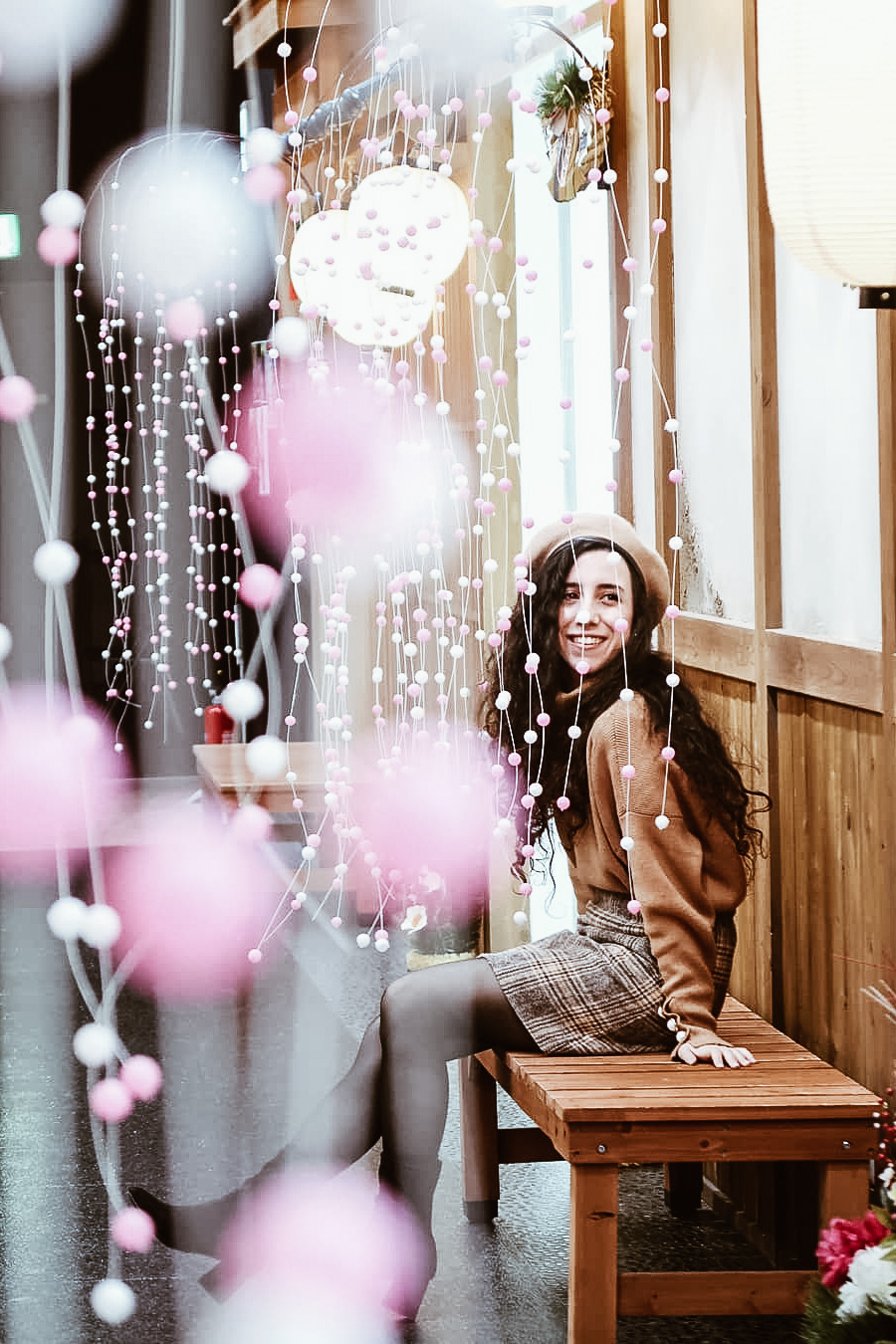

JIB: Quale città ha catturato il tuo cuore in Giappone?
S: Forse si potrà capire già da altre risposte ma amo Tokyo con tutto il cuore. Penso sia una città unica. Una città patchwork, fatta di scampoli arcobaleno di ogni tipo e forma. Un incastro straordinario di moderno e antico. Non ha forse la bellezza classica tipica di Kyoto, ha più il fascino dei luoghi vissuti fino in fondo, al massimo, quei luoghi in grado di raccontarti ad ogni angolo una storia, di stupirti ancora e ancora senza mai fallire. Questa città è un universo a parte, non si smette mai di capirla, di impararla.
Se parliamo di luoghi straordinari per bellezza e per ricordi devo citare allora anche Takaragawa Onsen, un dei posti più magici in cui io sia mai stata in Giappone. Di questo ryokan con onsen ne ho parlato anche sul blog. Sembra provenire da un'altra epoca, adagiato in mezzo alle foreste di Gunma, lontanissimo dalle città, posato sul corso del fiume Takara. Puro incanto.
JIB: La tua storia è davvero emozionante e siamo sicuri che tu riesca a vivere quotidianamente esperienze uniche e creare tanti ricordi che ti porterai sempre nel cuore. Vorresti condividere con noi uno dei momenti più divertenti o significativi che ti sono capitati da quando vivi in Giappone?
S: Una delle esperienze che più ho amato è stata portare il mikoshi durante il matsuri del mio quartiere. La sensazione di coesione della comunità e il senso stesso dei festival è qualcosa di fantastico.
E' stato incredibile poter vedere un matsuri nella sua interità, dal raduno dei partecipanti, al brindisi e preghiere d'inizio e avere l'opportunità di portare la divinità, all'interno del mikoshi, in modo che potesse venire ringraziata da tutti e garantire così fortuna e prosperità al quartiere e i suoi abitanti.

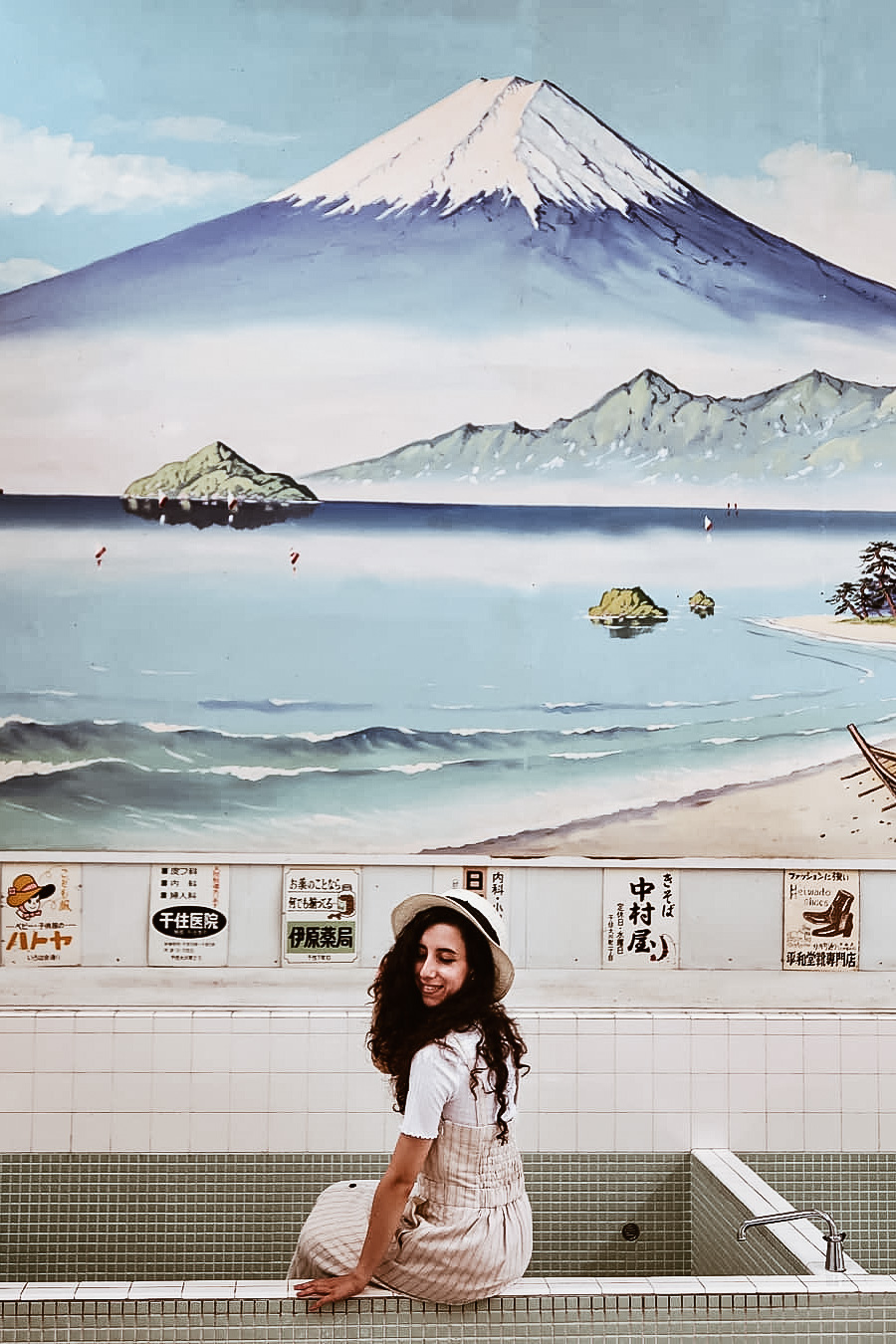
JIB: Deve essere stata un’esperienza davvero intensa. Invece da cosa è nato Il tuo blog, prossimafermatagiappone.com, e come hai sviluppato il concetto sino ad arrivare a ciò che è oggi?
S: Il blog è nato dalla voglia di riportare in parole l'amore smisurato che provo per il Giappone.
Ho sempre amato scrivere, fin da piccola, e ho pensato che raccontare di questo paese avrebbe potuto connettermi e aiutare tanti altri amanti del Giappone.
E' un blog di viaggio, ma spesso sono i sentimenti per i luoghi a farla da padrone, un genuino e totale entusiasmo per quello che vedo o quello che faccio.
L'affetto sincero per certi quartieri, il fascino che su di me esercitano l'antico e le tradizioni, i luoghi che cantano al mio cuore. Una cosa, che penso e spero si possa capire leggendo il blog, è che non scrivo per raccontare di viaggi fini a se stessi, ma di emozioni e di percorsi.
Parto dal presupposto che spesso anche un luogo quotidiano, meno visitato o meno famoso possa in realtà riservare grandi scoperte e tanta meraviglia.
Il blog è uscito fuori così, dalla sincerità dei miei sentimenti per il Giappone, per 4 anni, quasi ogni giorno ho pubblicato racconti, foto, itinerari, consigli per chi si appresta magari a partire per un viaggio, per studio o per vivere in Giappone.

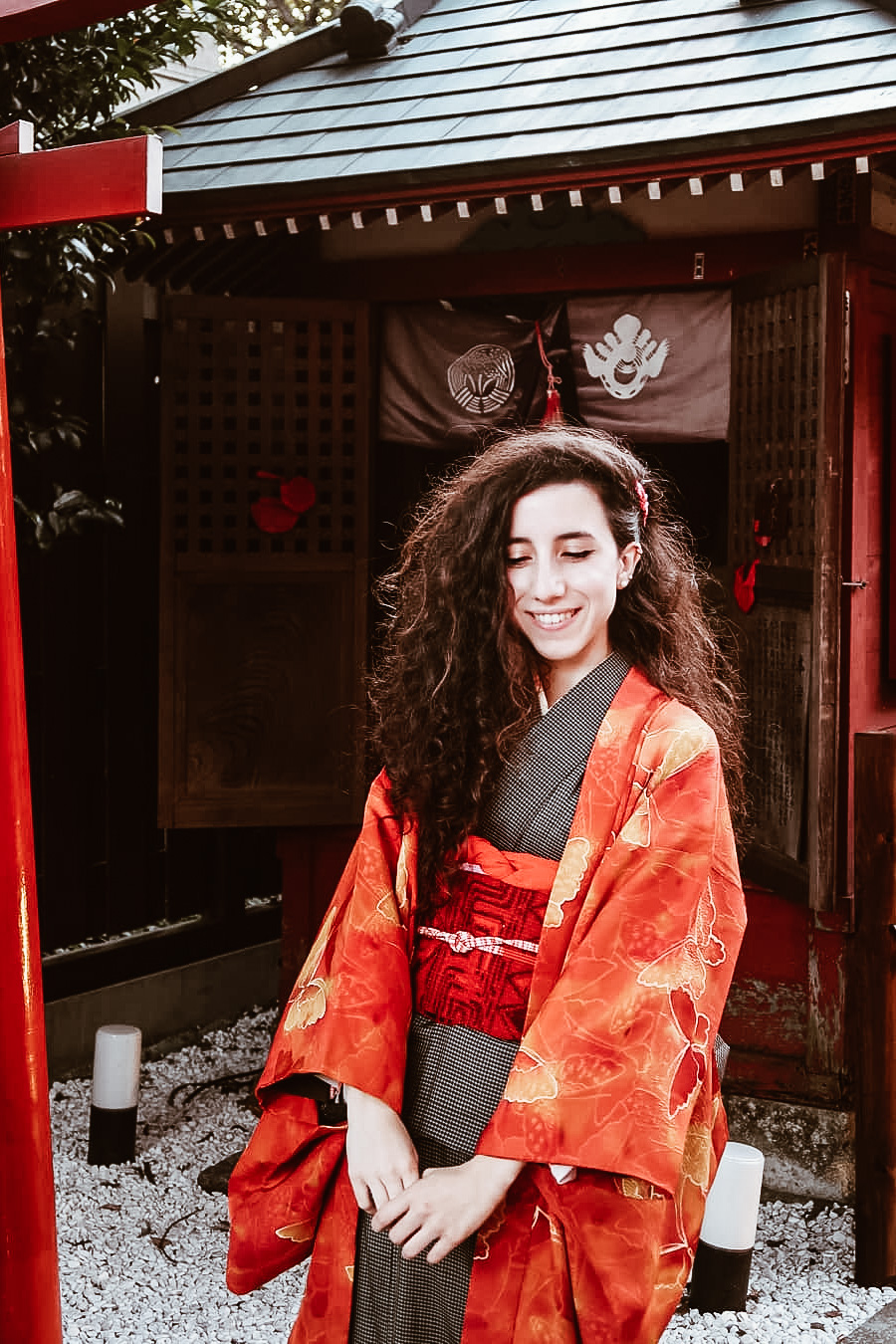
JIB: E’ davvero molto bello questo sentimento che ti ha mosso a creare il tuo blog, e questa è un’altra delle cose che abbiamo in comune. Tante persone come noi sognano di vivere in Giappone e fare lo stesso percorso che hai seguito tu. Tuttavia, come ben sappiamo, non è sempre oro tutto quel che luccica, e anche il Giappone, come un po’ in tutti i paesi, ha i suoi alti e bassi. Quali sono le difficoltà che hai riscontrato nei primi tempi nella terra del Sol Levante?
S: Devo dire che non ho mai riscontrato difficoltà enormi da quando mi sono trasferita. O meglio, niente che io non sia mai riuscita a superare con un po' di impegno o niente che io consideri in realtà particolarmente negativo.
E' divertente e di incerto risultato le prime volte che ti ritrovi a dover fare cose che in Italia avresti considerato normali, ma che qui rappresentano invece delle incognite: andare per la prima volta dal dottore, fare il contratto del telefono e più tardi imbarcarmi da sola nel contratto della casa e dover telefonare per far allacciare le utenze.
Il momento più difficile, anche quello una grande incognita, è stato la ricerca del lavoro, mesi davvero tosti e impegnativi, fatti anche di tanti no, di tanti “ce la farò? Non mollerò!”
Non è sempre facile il mercato del lavoro per uno straniero.
Per ultima ovviamente la lontananza da casa, vorrei sicuramente avere la possibilità di vedere più spesso la mia famiglia.
JIB: Quali sono i tuoi progetti per il futuro?
S: Anche se al momento il tempo scarseggia, mi piacerebbe lavorare di più con il blog. Collaborare di più con aziende locali, proporre più attività da fare in vacanza.
Sarebbe bello poter mostrare sempre più Giappone e spero di averne l'occasione.
Un altro sogno nel cassetto sarebbe quello di scrivere una guida, in particolare sulla Shitamachi, le antiche zone di Tokyo preservate, sopravvissute a incendi, terremoti e bombardamenti, queste aree ancora poco famose sono di una ricchezza unica.
Sono la mia parte preferita della città e vorrei parlarne più approfonditamente se mai ne avessi l'occasione.
Lavorativamente parlando in futuro mi piacerebbe fare in Giappone più esperienze nel campo del turismo, vorrei davvero impegnarmi in questo senso.

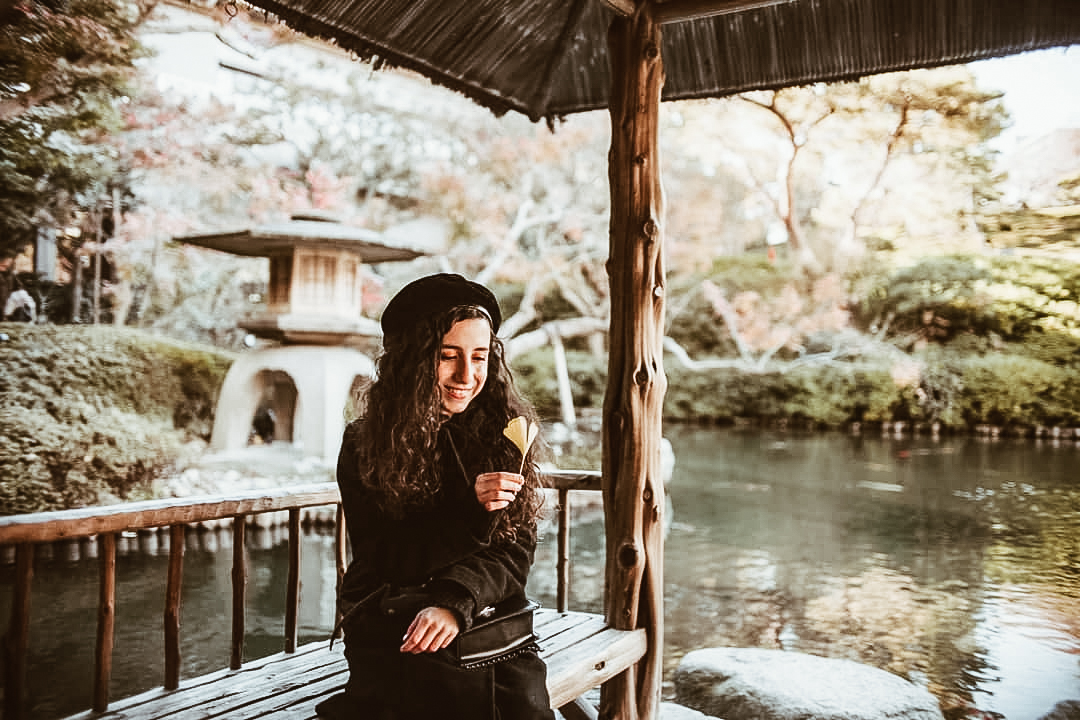
photo credits: @georgeyajima
JIB: E’ davvero molto interessante quello che stai condividendo con noi, e anche noi dall’Italia siamo convinti che ci sia bisogno di più informazioni riguardo a queste zone particolari solo del Giappone, che molto spesso vengono un po’ messe da parte dalla massa. Quali sono secondo te le connessioni più forti che trovi fra l’Italia e il Giappone?
S: si tratta penso di due Paesi profondamente diversi, ma sicuramente entrambi si portano dietro una storia millenaria, cultura e tradizioni grandissime e affascinanti. In entrambi i Paesi c'è un grande amore per il cibo, un grande amore per le proprie ricchezze artistiche.
JIB: Pensi ci sia un futuro per una collaborazione ancora più stretta fra le due nazioni?
S: Io spero di sì, soprattutto dal punto di vista turistico, penso ci sia un sempre maggior interesse per il Giappone.
I turisti italiani stanno aumentando da un paio di anni e questo interesse reciproco, questa curiosità di viaggio, spero apra le porte a nuove possibilità.
Sarebbe bello inoltre si potesse avere il working holiday anche per gli italiani in futuro.

JIB: Ti manca mai l’Italia? Pensi di tornare stabilmente qui?
S: Come dicevo prima, dell'Italia mi mancano le persone, la mia famiglia, le amicizie italiane. Se non avessi delle buone amiche italiane qui sarebbe doppiamente difficile.
L'altra grave mancanza sono i salumi e i formaggi (più che pasta e pizza che qui si trovano fatti benissimo), c'è una selezione scarsissima e costosissima per lo più. La tristezza di non potersi fare un mega panino al salame!
Forse prima o poi tornerò in Italia o in Europa comunque, ma per ora è difficile dire cosa mi riservi il futuro. Per il momento vorrei restare in Giappone.
JIB: E anche noi speriamo tu possa rimanere in Giappone! Grazie mille per il tempo che ci hai dedicato e per le bellissime parole e momenti che hai condiviso con noi. Un ultima cosa, lancia un saluto e un consiglio a tutti i nostri lettori
S: Vi ringrazio innanzitutto per l'intervista, siete state carinissime ad ospitarmi.
Sarei davvero felice se sempre più persone potessero leggere il blog e trovarvi spunti, che siano di viaggio o di vita in Giappone, io sono sempre disponibile a dare una mano a chiunque si trovi in cerca di risposte sul tema.
A chi vorrebbe magari studiare o vivere in Giappone dico di non abbandonare il proprio sogno, può essere un Paese difficile sotto certi aspetti, ma se lo si ama e si vuole tentare, perché no?
L'unico suggerimento è di venire pronti, il Giappone dà tanto ma chiede anche tanto.
E se la vita di uno studente può essere abbastanza tranquilla, quella di un lavoratore a tempo pieno ha dei ritmi spesso frenetici.
Anche il visto lavorativo richiede nel 99% dei casi una laurea, senza la quale è poco probabile che l'immigrazione rilasci il visto. Molti lavori d'ufficio o relativi al turismo richiedono inoltre spesso una capacità di parlato che sia business / N2.
Venite in Giappone tenendo in mente queste cose e perseverate finché non avrete ottenuto ciò che più vi rende felici!
Un abbraccione a tutti i lettori!
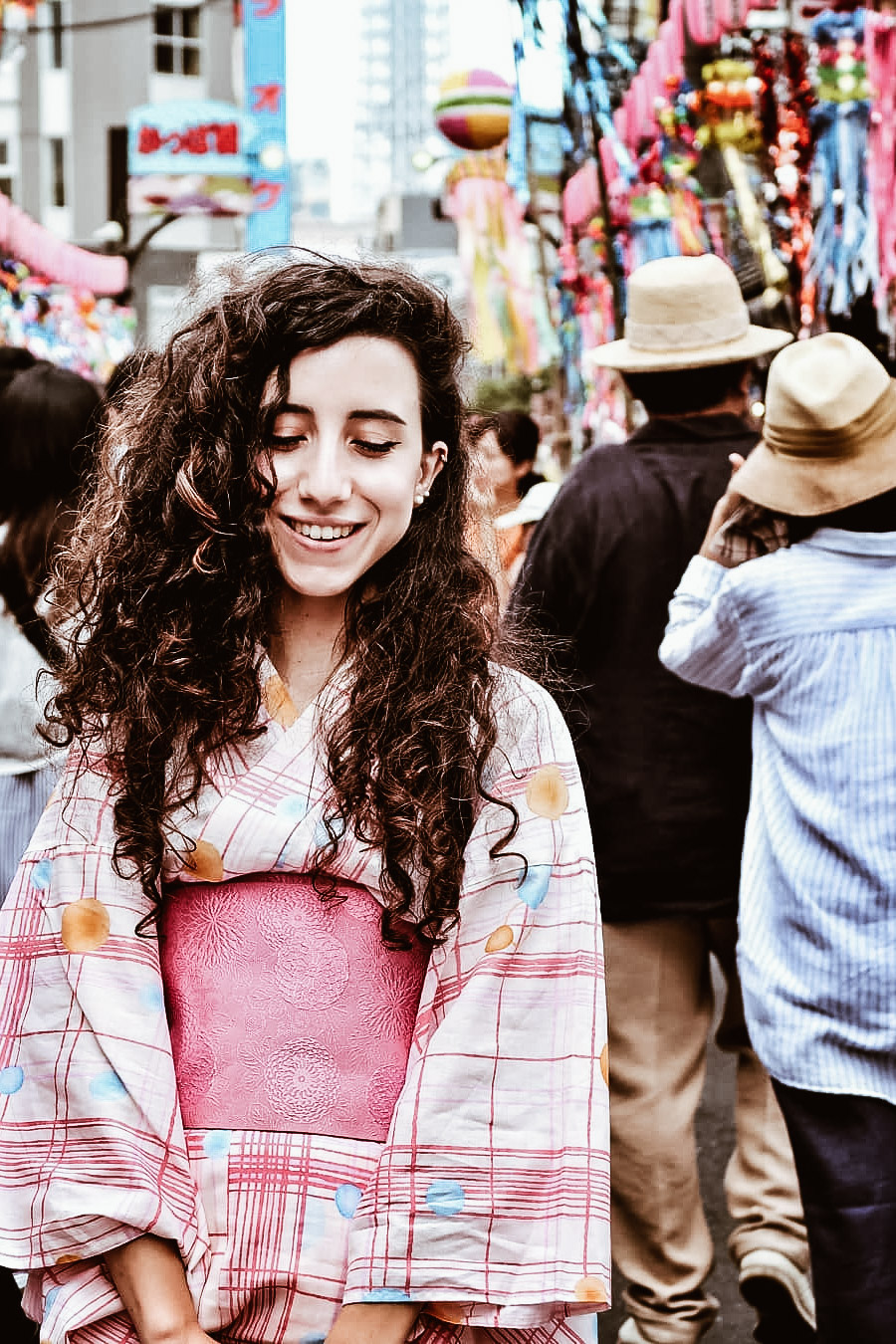
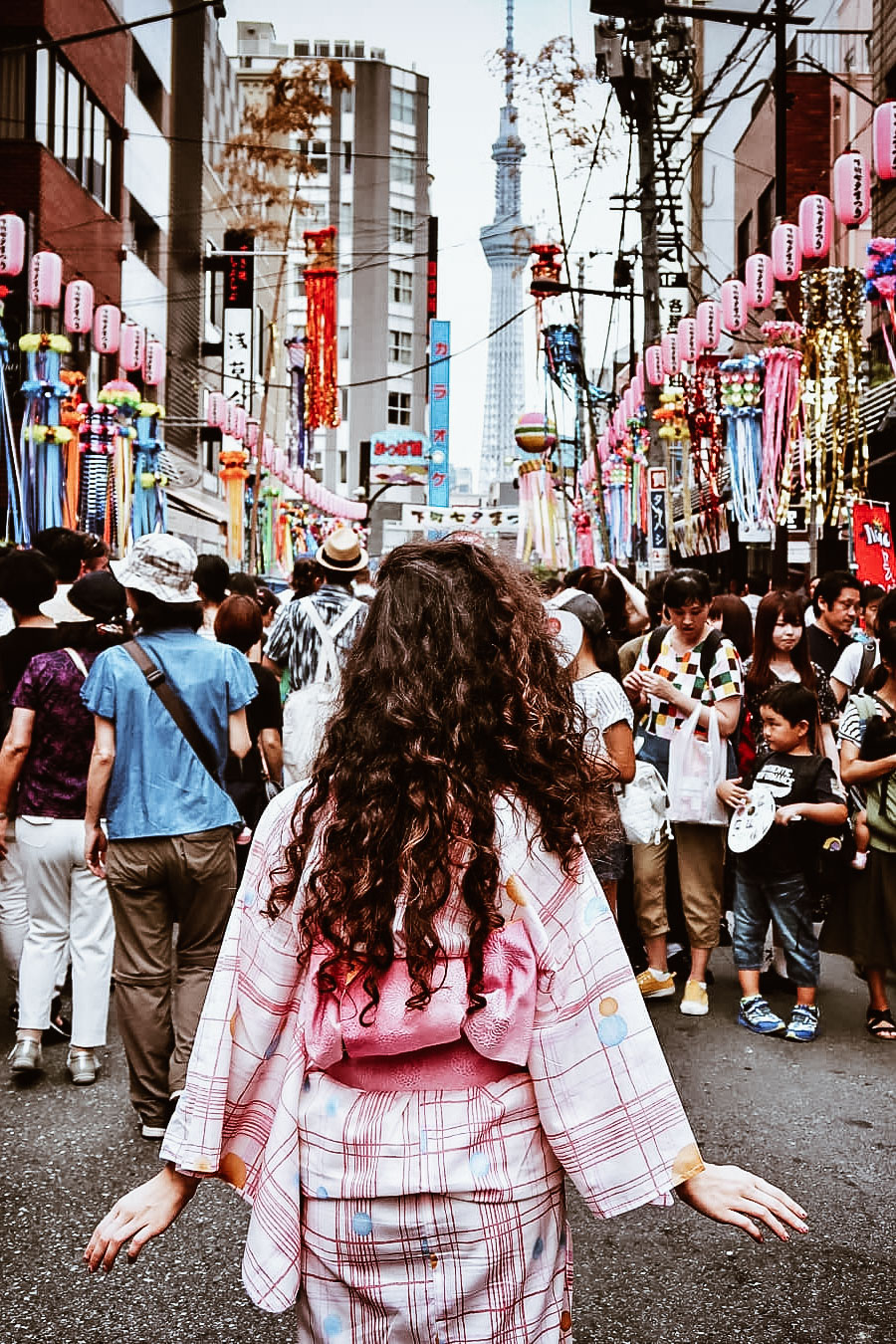
Segui Stefania
Blog: prossimafermatagiappone.com
Facebook: facebook.com/Prossimafermatagiappone/
Instagram: @prossimafermatagiappone
Japan Traditions: Wakakusa Yamayaki Matsuri
Uno dei matsuri più famosi del Giappone è il Wakakusa Yamayaki Matsuri che si tiene nella città di Nara il quarto sabato di gennaio.
photo credits: matsuritracker on flickr
Le Origini
Sulla cima della terza collina del Monte Wakakusa troviamo il Uguisuzuka Kofun, una pietra tombale a forma di buco di serratura.
Leggende dicono che in passato se si bruciava la montagna per la fine di gennaio nel periodo del nuovo anno, era possibile respingere i mostri che ritornavano dalle loro tombe. Al contrario, qualora la montagna non venisse bruciata entro la fine di gennaio, un grosso periodo di sfortuna giaceva davanti per la città di Nara. Come risultato, le storie raccontano che le persone che passavano accanto al Monte Wakakusa cominciarono a incendiare la montagna senza permesso.
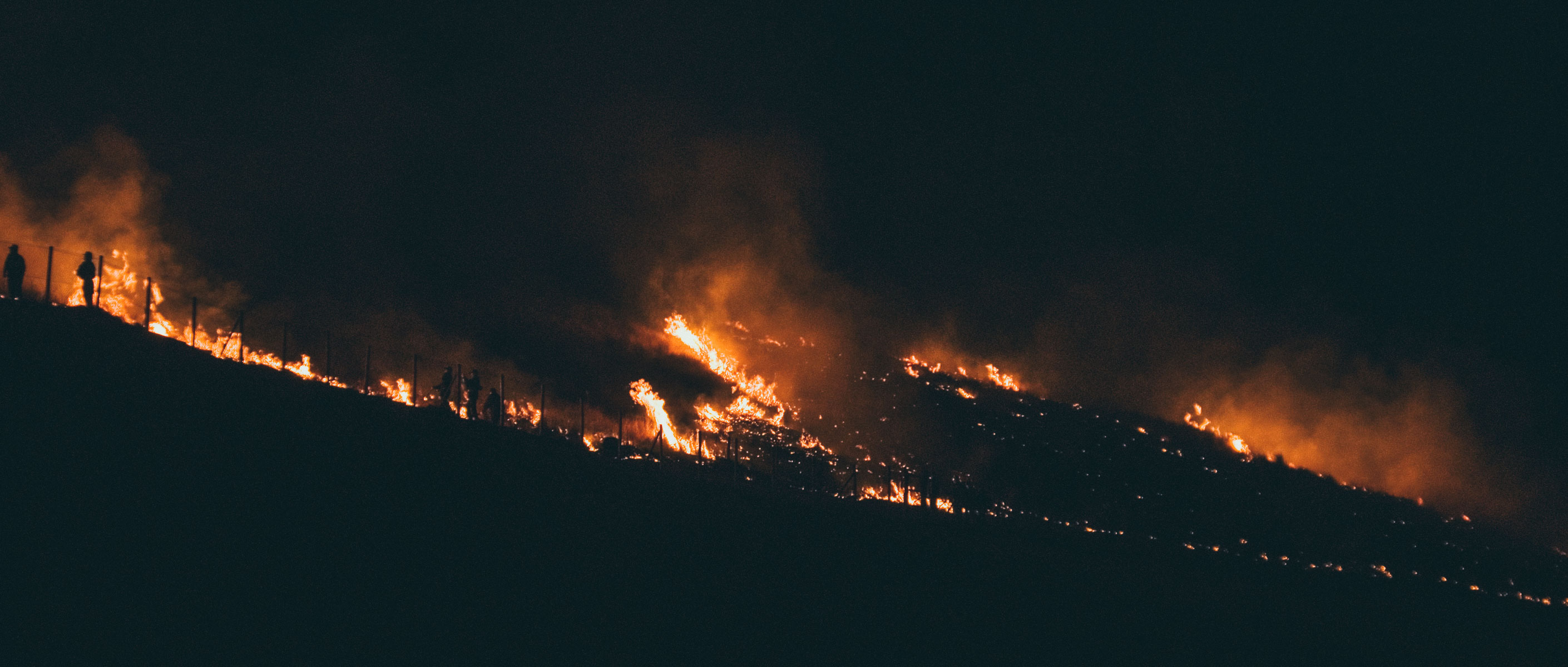
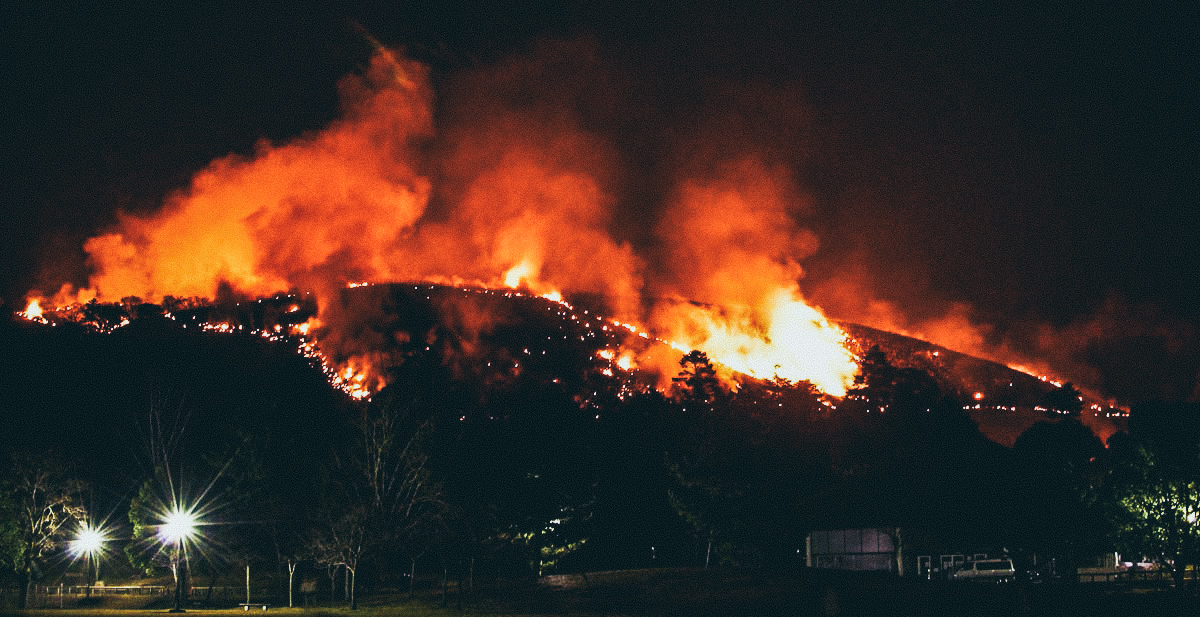
photo credits: smartus & matsuritracker on flickr
A seguito di ciò, ci furono alcuni incidenti dove il fuoco proveniente dal monte Wakakusa arrivò ad avvicinarsi ai confini del tempio Todaiji e Kohfukuji ripetutamente. A causa di questo, nel dicembre 1738, l’ufficio della magistratura di Nara (Bugyosho) proibì le persone dalla pratica di incendiare la montagna. Tuttavia, gli incendi dolosi continuarono per mano di anonimi e in alcune occasioni si avvicinava alle città e i templi vicini. Per evitare pericoli simili, la città di Nara stabilì una regola per permettere alle persone di bruciare la montagna con la partecipazione di rappresentanti dei tempi Todaiji e Kohfukuji assieme al Nara Bugyosho alla fine del periodo Edo.

photo credits: toshimo1123 on flickr
Il festival Yamayaki (montagna bruciante) deriva dalle superstizione per calmare gli spiriti dei morti allo Uguisuzuka Kofun localizzata in cima alla montagna, quindi il Yamayaki potrebbe essere anche considerato come un momento di raccolto alla memoria dei defunti.
Storia moderna e odierna
Dal 1900, si susseguirono una serie di cambiamenti legati al Wakakusa Yamayaki Matsuri. In primis, l’orario fu spostato dal diurno al serale e anche la sua data si spostò all’11 febbraio (Giorno dell’impero), anche se durante il periodo della Seconda Guerra Mondiale, le celebrazioni si tennero durante il pomeriggio. A seguito, nel 1910, l’organizzazione passò in mano alla prefettura di Nara.


photo credits: karihaugsdal on flickr
Dopo la fine della guerra, lo Yamayaki divenne nuovamente un evento serale assieme ad uno spettacolo pirotecnico di oltre cento fuochi artificiali.
Durante gli anni cinquanta, la data dello Yamayaki fu spostata al 15 gennaio, il “Giorno della Maggiore età”, mentre nel 1999, a causa dell’implementazione del cosiddetto “Happy Monday System Act” (legge che spostò alcune feste pubbliche al lunedì), il festival venne celebrato la domenica prima del “Giorno della maggiore età”.
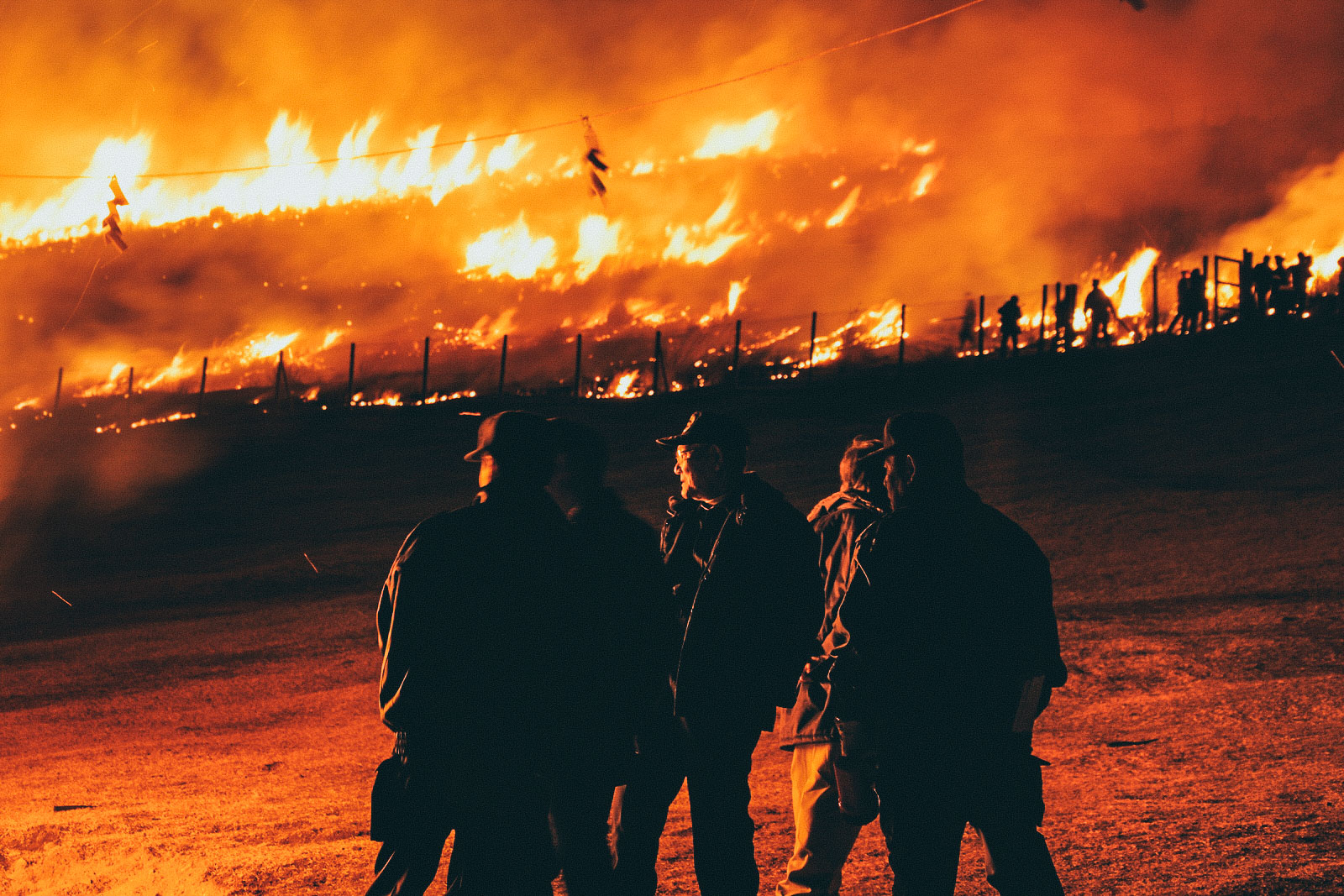

photo credits: toshimo1123 & nwhitely on flickr
Dal 2009 troviamo la combinazione che ancora oggi esiste, ovvero l’evento si tiene il quarto sabato di gennaio con uno spettacolo pirotecnico di centinaia di fuochi artificiali. Questi ultimi, sono l’unico evento a Nara che usa i fuochi d’artifico Shakudama che hanno un diametro di oltre 30cm. Uno spettacolo pirotecnico assolutamente magico che vi assicuriamo rimarrà per sempre impresso nei vostri ricordi.
Il monte Wakakusa
Il monte Wakakusa è alto 342 metri e largo 33 ettari ed è ricoperto di erba con discese delicate. Qui si possono vedere cervi, fiori stagionali e piante, come i tradizionali ciliegi giapponesi in primavere e i fantastici colori autunnali tipici del Giappone. Inoltre dalla sua cima, è possibile vedere tutto il panorama della città di Nara con tutta la sua parte storica.

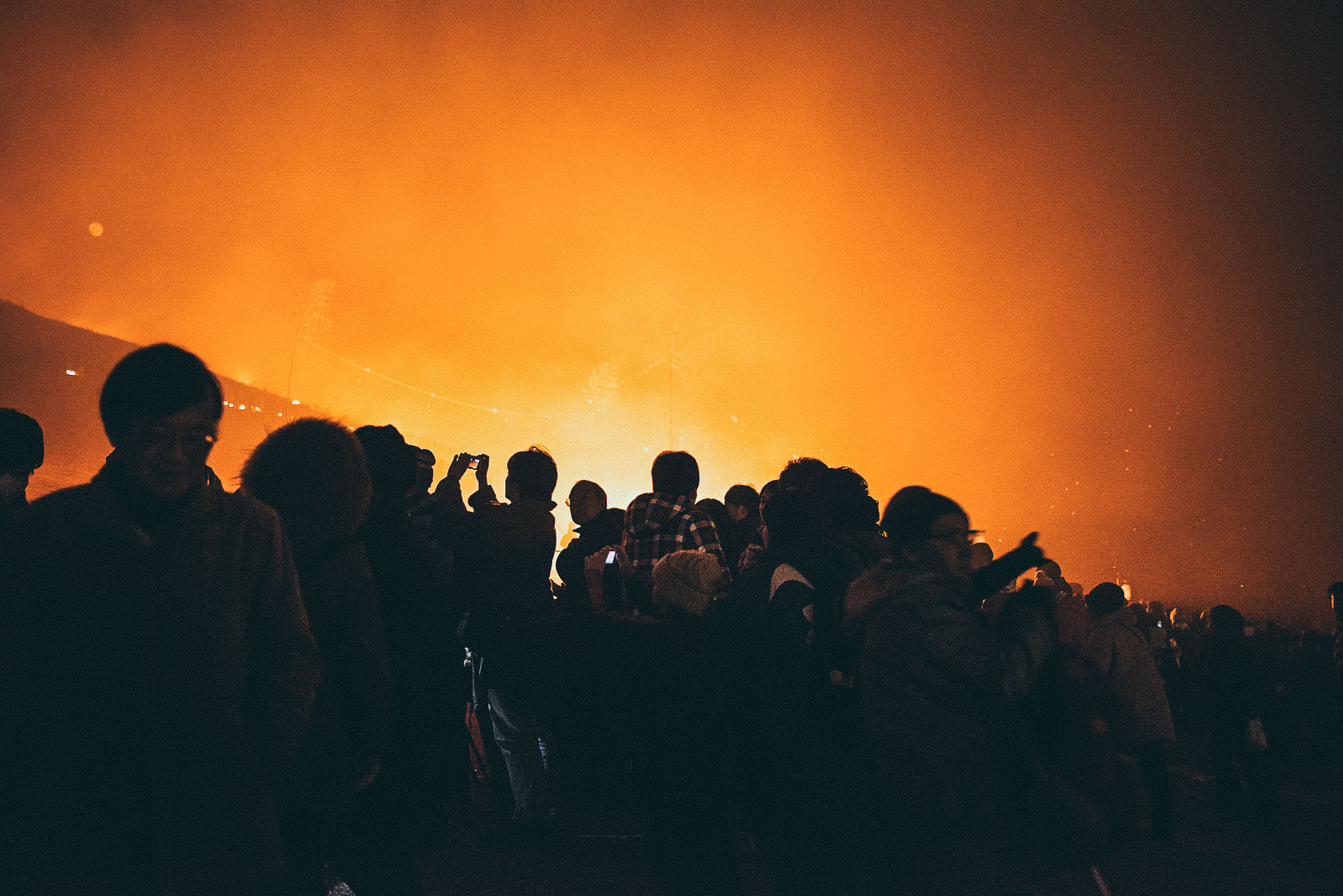
photo credits: 158175735@N03 & mashipooh on flickr
Il monte Wakakusa è circondato da molti patrimoni mondiali dell’UNESCO come i templi Todaiji e Kohfukuji e la foresta primaverile del monte Kasuga, quindi è bene prestare la massima attenzione onde evitare incidenti come far diffondere il fuoco.
La parata
Guidata dal rumore dei corni di conchiglia suonati dal preti della montagna del Tempio Kinpusenji, più di 40 persone affrontalo la parata solenne attraverso il parco, indossando i costumi tradizionali dei rappresentanti dei templi di Kasugataisha, Todaiji e Kohfukuji e degli ufficiali dell’ufficio della magistratura di Nara nel periodo Edo.
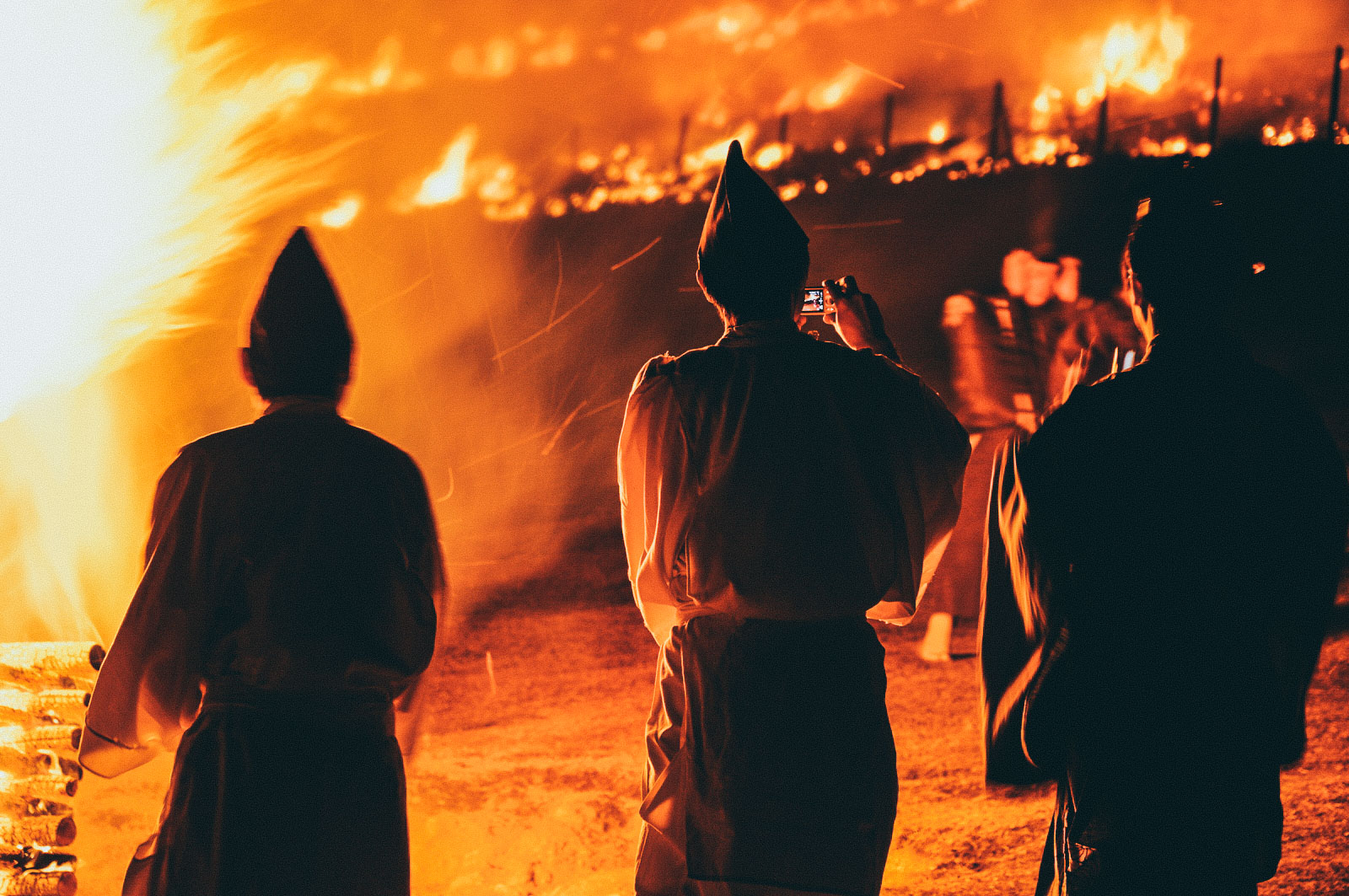
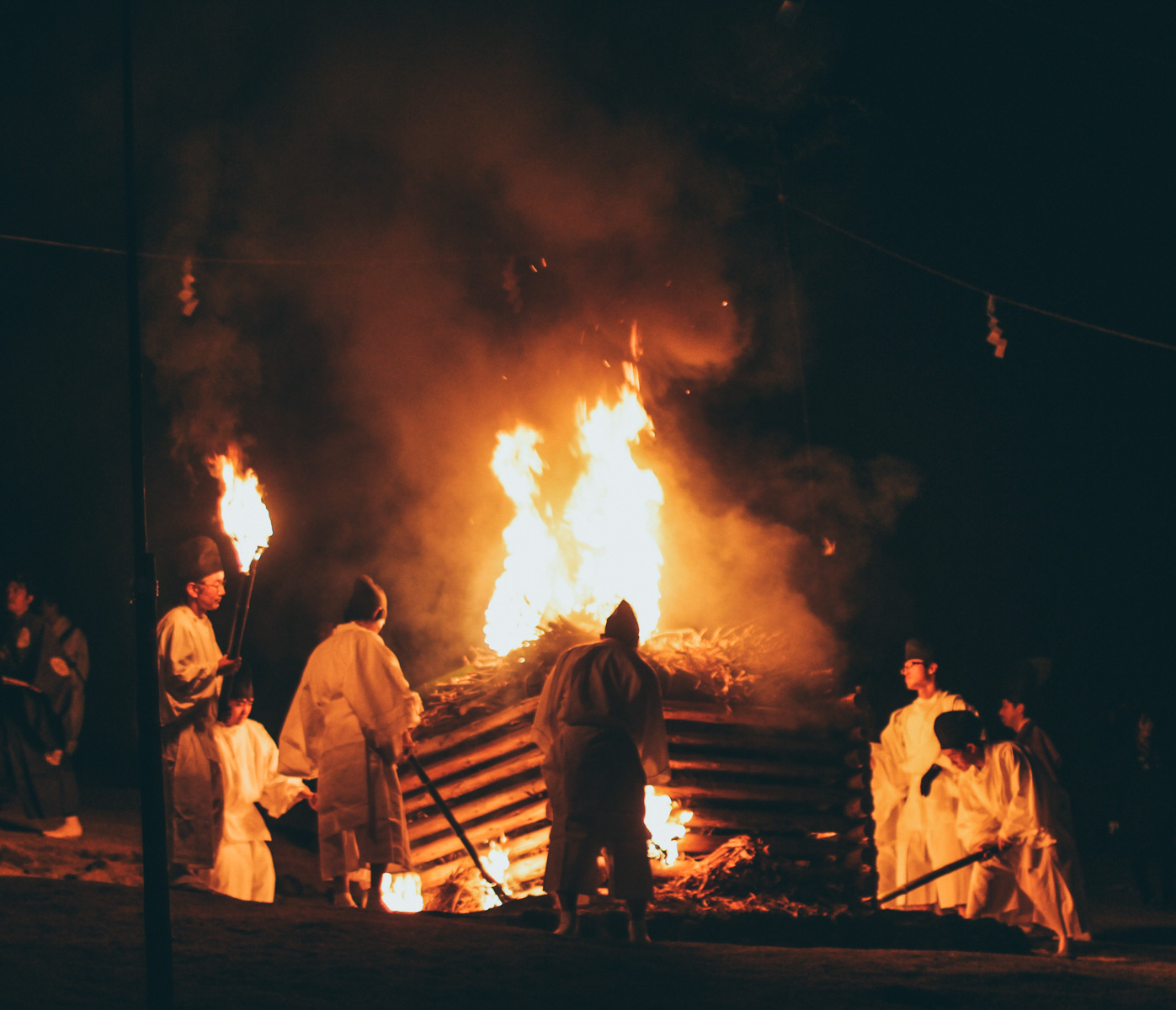
photo credits: toshimo1123 & katiefujiapple on flickr
L’evento comincia con il Gojinkahotaisai, la Cerimonia di accettazione del fuoco sacro che si tiene al parco Tobohino, sul luogo del Grande falò Tondo. In questa cerimonia, il fuoco sacro viene trasferito dal Grande Falò Tondo alle torce. A seguito di ciò, parte la parata che porterà il fuoco sacro sino al tempio Nogami. Una volta arrivati al tempio Mizuya, il sacro fuoco portato dal tempo Kasugataisha sarà trasferito ad una serie di torce. Una volta arrivato al Tempio Nogami, alla base del monte Wakakusa, il fuoco sacro va a formare un altro grande falò.

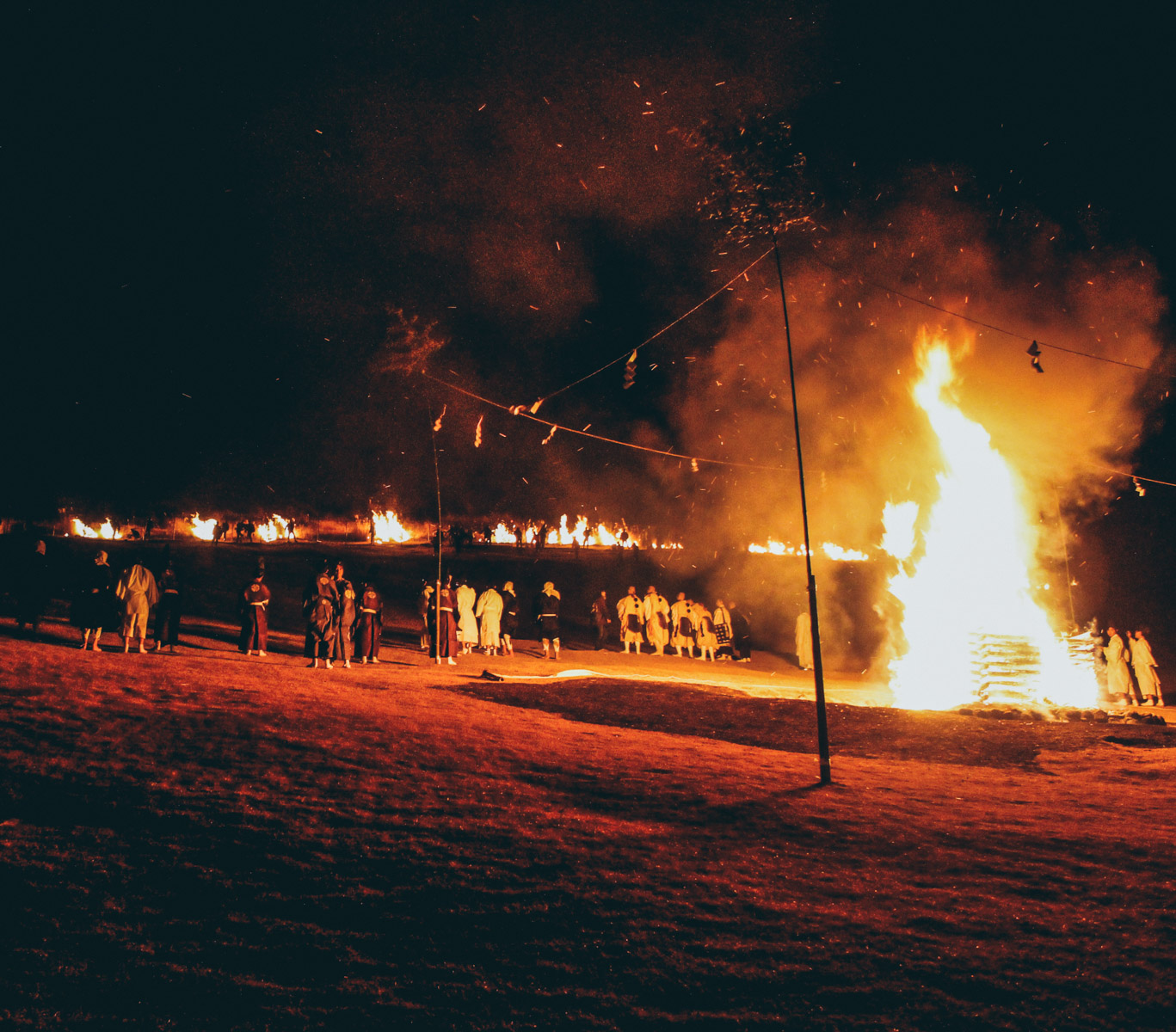
photo credits: katiefujiapple on flickr
Durante la parata, il fuoco è accompagnato da costanti preghiere in primis per la sicurezza dello Yamayaki. A seguire il fuoco viene trasferito nuovamente alle torce, accompagnato dai canti dei preti dei templi todaji, Kohfukuji e Kinpusenji. A questo punto, la parata si sposta verso il grande falò al centro della base della montagna dove viene acceso, dando così inizio allo spettacolo di luce e calore.
photo credits: nara-park.com
Accesso
Il monte Wakakusa si trova a circa 10 - 15 minuti a piedi dal tempio Todaiji e dal Kasuga Taisha. La montagna può anche essere raggiunta a piedi dalla stazione di Kintetsu Nara in circa 35 minuti o dalla stazione JR di Nara in circa 50 minuti. In alternativa potete utilizzare gli autobus in partenza sia dalla stazione che da Kasuga Taisha ad un piccolo costo.
Se siete in Giappone in questo periodo, il prossimo Yamamaki avrà luogo fra qualche giorno, il 26 gennaio 2019. Non perdetevelo e aspettiamo i vostri racconti!

photo credits: ks_photograph
Japan History: Hasekura Tsunenaga

photo credits: wikimedia.org
Tsunenaga Rokuemon Hasekura (1571 – 7 agosto 1622) è stato un samurai giapponese e servitore di Date Masamune, il daimyō di Sendai, famoso per aver condotto numerose delegazioni di ambasciatori che lo hanno portato a girare tutto il mondo.
Condusse una delegazione di ambasciatori in Messico e in seguito in Europa tra il 1613 e il 1620, dopodiché ritornò in Giappone. Fu il primo ufficiale giapponese mandato in America ed il primo a creare relazioni tra Francia e Giappone.
Gli Spagnoli iniziarono i viaggi tra il Messico ("Nuova Spagna") e la Cina, attraverso la loro base territoriale nelle Filippine, a seguito dei viaggi di Andrés de Urdaneta nel XVI secolo. Manila diventò la loro base definitiva per la regione Asiatica nel 1571.
I contatti con il Giappone, cominciarono a causa dei continui naufragi delle navi sulle coste Giapponesi, a quel punto gli Spagnoli hanno cominciato a sperare di espandere la fede Cristiana in Giappone. I tentativi di espandere la loro influenza in Giappone incontrarono una forte resistenza da parte dei Gesuiti, che avevano iniziato l'evangelizzazione del paese nel 1549, nonché dei portoghesi e degli olandesi che non si auguravano di vedere la Spagna commerciare con i Giapponesi.
Nel 1609 il galeone Spagnolo San Francisco a causa del cattivo tempo sulla sua via da Manila a Acapulco, naufragò sulla costa Giapponese a Chiba. I marinai furono salvati, e il capitano della nave, Rodrigo de Vivero y Aberrucia, incontrò Tokugawa Ieyasu.
Un trattato in base a cui gli Spagnoli avrebbero potuto costruire un'industria nell'est del Giappone, fe per cui alle navi spagnole sarebbe stato permesso di visitare il Giappone in caso di necessità fu firmato il 29 novembre 1609.
Il progetto dell'ambasciata
Luis Sotelo, un frate francescano che stava facendo proselitismo nella zona di Tokyo, convinse lo Shōgun ad inviarlo come ambasciatore in Nueva España (Messico). Nel 1610 navigò verso il Messico con i marinai spagnoli e 22 giapponesi, a bordo della San Buena Ventura, una nave costruita dall'inglese William Adams per lo Shogun. Una volta in Nuova Spagna, Luis Sotelo incontrò il viceré Luis de Velasco, che accettò di inviare un ambasciatore in Giappone, nella persona del famoso esploratore Sebastián Vizcaíno, con la missione di esplorare le "Isole di oro e argento" che si pensava si trovassero a est delle isole giapponesi.
Vizcaíno arrivò in Giappone nel 1611 ed ebbe molti incontri con lo Shogun e i signori feudali, ma non era molto rispettoso delle usanze giapponesi, e trovò i giapponesi contro il proselitismo cattolico. Vizcaino alla fine partì alla ricerca dell'"Isola d'argento", nel corso della quale incontrò brutto tempo, che lo costrinse a tornare in Giappone con gravi danni. Lo Shogun decise di costruire un galeone in Giappone, allo scopo di riportare Vizcaino in Nuova Spagna.
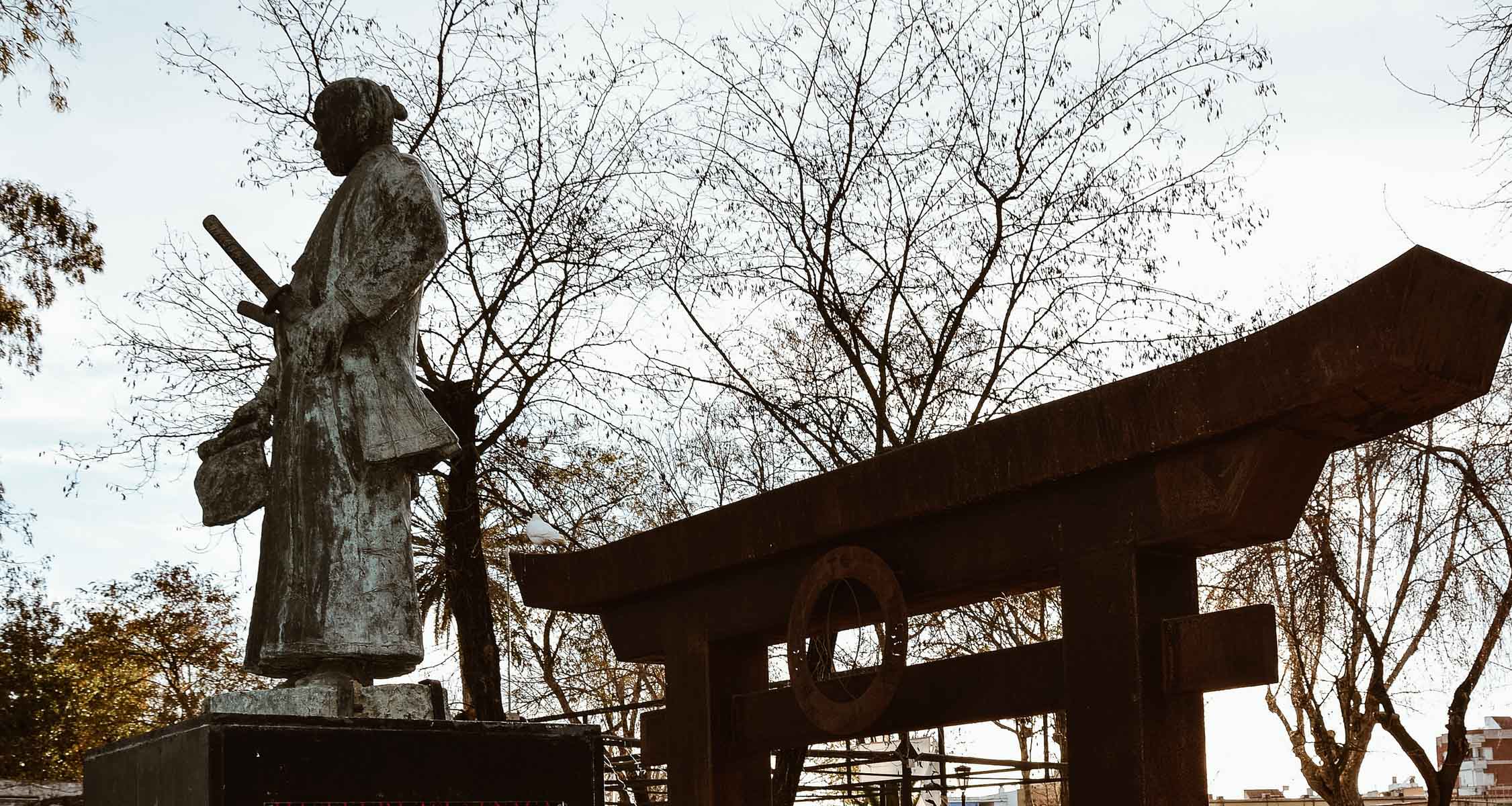
Statua di Hasekura Tsunenaga a Coria del Río
photo credits: tradurreilgiappone.com
A Date Masamune venne dato il comando e nominò uno dei suoi inservienti, Hasekura Tsunenaga, a capo della missione. Per costruire il galeone, chiamato Date Maru dai giapponesi e successivamente San Juan Bautista dagli spagnoli, ci vollero 45 giorni, con la partecipazione di esperti tecnici dal Bakufu, 800 operai navali, 700 fabbri, e 3.000 carpentieri.
Dopo il suo completamento, la nave salpò il 28 ottobre 1613 da Ishinomaki per Acapulco in Messico, con circa 180 persone di equipaggio, tra cui 10 samurai dello Shogun, 12 samurai di Sendai, 120 tra mercanti, marinai e servi giapponesi.
La nave arrivò ad Acapulco il 25 gennaio 1614 dopo tre mesi di navigazione, e una cerimonia accolse l'ambasciata. Prima del viaggio in Europa, l'ambasciata trascorse del tempo in Messico, visitando Veracruz per poi imbarcarsi sulla flotta di Don Antonio Oquendo. Gli emissari partirono per l'Europa sulla San Jose il 10 giugno, e Hasekura dovette lasciare la gran parte del gruppo di mercanti e marinai asiatici ad Acapulco.
La flotta giunse a Sanlúcar de Barrameda il 5 ottobre 1614.
L'ambasciata giapponese incontrò il re di Spagna Filippo III a Madrid il 30 gennaio 1615. Hasekura consegnò al sovrano una lettera da Date Masamune, e l'offerta per un trattato. Il re rispose che avrebbe fatto quello che sarebbe stato in suo potere per venire incontro alle richieste.
Hasekura fu battezzato il 17 febbraio dal cappellano personale del re, e rinominato Felipe Francisco Hasekura.
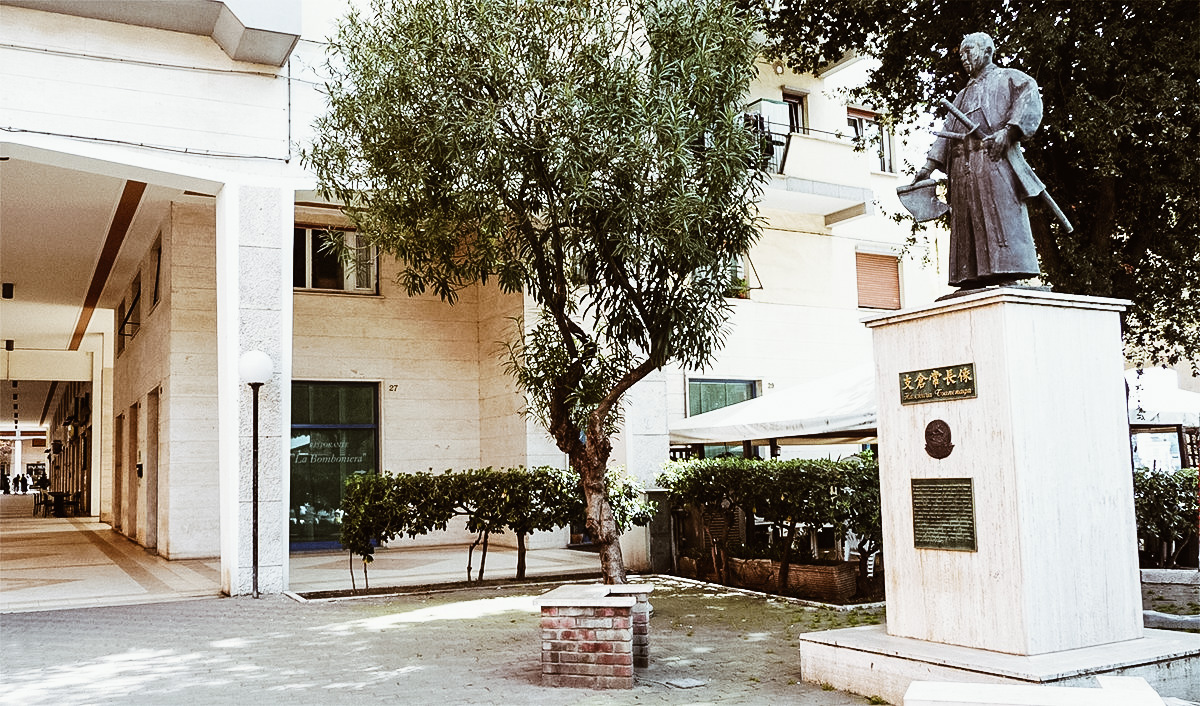
Statua di Hasekura Tsunenaga a Civitavecchia
photo credits: tradurreilgiappone.com
Francia
Dopo il viaggio attraverso la Spagna, l'ambasciata salpò nel Mar Mediterraneo a bordo di tre fregate spagnole verso l'Italia. A causa del cattivo tempo, le navi restarono nella baia francese di Saint Tropez, dove furono ricevute dalla nobiltà locale, con stupore della popolazione.
La visita dell'ambasciata giapponese è registrata nelle cronache della zona come una delegazione guidata da "Filippo Francesco Faxicura, Ambasciatore presso il Papa, da Date Masamune, Re di Woxu in Giappone".
Vennero ricordati molti dettagli pittoreschi del loro comportamento e del loro aspetto:
"Non toccano mai il cibo con le mani, ma usano due sottili bacchette che tengono con tre dita".
"Si soffiano il naso in soffici fogli setosi della grandezza di una mano, che non usano mai due volte, e che quindi buttano per terra dopo l'uso, e furono deliziati nel vedere che le persone attorno a loro si precipitavano a raccoglierli".
"Le loro spade tagliano così bene che possono tagliare un sottile foglio di carta appoggiandovelo sul bordo e soffiandoci sopra."
("Relazioni di Mme de St Tropez", ottobre 1615, Bibliothèque Inguimbertine, Carpentras).
La visita di Hasekura Tsunenaga a Saint Tropez nel 1615 è il primo esempio documentato di relazioni tra Francia e Giappone.
Italia
L'ambasciata giapponese arrivò in Italia, riuscendo ad ottenere udienza da papa Paolo V a Roma, nel novembre 1615, sbarcando nel porto di Civitavecchia, ragione per cui ancora oggi Civitavecchia è gemellata con la città giapponese di Ishinomaki. Hasekura consegnò al papa una lettera decorata d'oro, con una formale richiesta di un trattato commerciale tra Giappone e Messico, oltre che l'invio di missionari cristiani in Giappone. Il papa accettò senza indugio di disporre l'invio di missionari, ma lasciò la decisione di un trattato commerciale al re di Spagna. Il papa scrisse poi una lettera per Date Masamune, della quale una copia è a tutt'oggi conservata in Vaticano. Il Senato di Roma conferì a Hasekura il titolo onorifico di Cittadino Romano, in un documento ch'egli successivamente portò in Giappone e che oggi è ancora visibile e conservato a Sendai. Nel 1616, l'editore francese Abraham Savgrain pubblicò un resoconto della visita di Hasekura a Roma: "Récit de l'entrée solemnelle et remarquable faite à Rome, par Dom Philippe Francois Faxicura" ("Racconto della solenne e notevole entrata fatta a Roma da Don Filippo Francesco Faxicura").

Conferimento della cittadinanza romana onoraria a "Hasekura Rokuemon"
photo credits: wikimedia.org
Seconda visita in Spagna
Per la seconda volta in Spagna, Hasekura incontrò il re, che declinò l'offerta di un trattato commerciale, perchè pensava che l’ambasceria giapponese non sembrava una delegazione ufficiale del sovrano del Giappone, Tokugawa Ieyasu, il quale, al contrario, aveva promulgato un editto nel gennaio 1614 ordinando l'espulsione di tutti i missionari dal Giappone, e aveva cominciato la persecuzione della fede cristiana nel Paese. L'ambasceria lasciò Siviglia per il Messico nel giugno 1616 dopo un periodo di due anni in Europa. Alcuni dei giapponesi restarono in Spagna, più precisamente in un villaggio vicino a Siviglia (Coria del Río), e i loro discendenti hanno ancora il cognome Japón.
Ritorno in Giappone
Nell'aprile 1618 la San Juan Bautista giunse nelle Filippine dal Messico, con Hasekura e Luis Sotelo a bordo. La nave fu acquistata dal governo spagnolo, con l'obiettivo di costruire difese contro gli olandesi. Hasekura ritornò in Giappone nell'agosto 1620 e trovò il Giappone molto cambiato: la persecuzione dei cristiani nello sforzo di sradicare il Cristianesimo era attiva dal 1614, e il Giappone stava muovendosi verso il periodo "Sakoku", caratterizzato da un imperante isolazionismo. A causa di queste persecuzioni, gli accordi commerciali col Messico che aveva cercato di stabilire furono negati, e gran parte degli sforzi in questo senso erano stati vani.
Sembra che l'ambasciata da lui rappresentata, abbia avuto pochi risultati, ma che abbia invece accelerato la decisione dello Shogun Tokugawa Hidetada di cancellare le relazioni commerciali con la Spagna nel 1623, e quelle diplomatiche nel 1624.
Cosa fu di Hasekura dopo l'avventura diplomatica è ignoto, e le storie sui suoi ultimi anni sono numerose. Alcuni sostengono che abbia abbandonato il Cristianesimo, altri che difese la sua fede così profondamente da diventare un martire, e altri che sia rimasto cristiano nell'intimità, professando la sua fede in segreto. Hasekura morì nel 1622, e la sua tomba è ancora oggi visibile nel tempio buddista di Enfukuji nella prefettura di Miyagi.
Una curiosità, nel 2015, ricorreva il 400° anniversario dall'arrivo della Keichō Kenō Shisetsudan" (ambasceria verso l'Europa dell'era Keichō), prima ambasceria ufficiale dal Giappone. Un corteo in costume storico ha sfilato nella via principale di Civitavecchia per una rievocazione storica dell'ingresso in città dell'ambasceria guidata Hasekura Tsunenaga. La sera, presso la Chiesa dei SS. Martiri Giapponesi, alla presenza del Sindaco di Civitavecchia Antonio Cozzolino, del Vice Direttore dell'Ufficio Politiche per la Ricostruzione della città di Ishinomaki, Junichi Kondō, dell'Ambasciatore del Giappone Kazuyoshi Umemoto e Consorte e di cittadini di entrambe le città, si è tenuto un concerto a cura di musicisti coristici del luogo.

Ambasciata del Giappone in Italia
photo credits: it.emb-japan.go.jp
Japan Travel: Meiji Shrine
L’Era Meiji
Il Periodo Meiji (明治時代 Meiji jidai, "periodo del regno illuminato") è uno dei momenti storici più famosi del Giappone. Si espande dal 23 ottobre 1868 sino al 30 luglio 1912 e comprende i 44 anni di regno dell’Imperatore Matsuhito.

photo credit: Wikipedia
A seguito della caduta dello shōgunato di Tokugawa Yoshinobu, cominciò l’era dell’imperatore Meiji, il primo dotato di potere politico. E’ proprio durante questi anni che si incominciò a modificare la struttura politica, sociale ed economica del Giappone basandosi sul modello occidentale.
A seguito della morte di Tokugawa Ieyasu nel 1866, fu nominato suo successore Tokugawa Yoshinobu, che rimase al potere pochi mesi, fino al novembre 1867, lo shōgun presentò le dimissioni e cedette i suoi poteri alla corte. Nel gennaio 1868, le truppe di Tokugawa furono sostituite a Kyoto attraverso un colpo di stato. Ed è proprio in questo periodo che comincia la Restaurazione Meiji che restituì il potere all’imperatore dopo secoli di dominio degli shōgun.

photo credit: Wikipedia
La prima azione esercitata dal nuovo governo Meiji fu quella di dare qualche privilegio in più alla classe dei samurai, rimasta insoddisfatta dal regime precedente. In seguito ai numerosi contrasti nel 1869 i daimyō furono nominato governatori dei loro feudi. Tuttavia questi ultimi vennero soppressi nel 1871, permettendo la centralizzazione “formale” del potere e il rinforzo dell’istituzione imperiale. Non tutti approvarono la rinuncia del proprio feudo, ma per mantenere ordine e stabilità, il governo persuase i daimyō con promesse di forti ricompense.
Assieme a questo compromesso, il governo si accordò anche con la classe samurai, approvando una legge che consentiva loro di svolgere qualsiasi occupazione nel campo degli affari e nella pubblica amministrazione (le più gettonate erano l’organo istituzionale di polizia e l’esercito imperiale). A seguito di ciò, il mantenimento della classe dei samurai venne assunto dal governo centrale, elargendo anche remunerazioni nei loro confronti.
In questo nuovo stato, l’immagine dell’imperatore diveniva sempre più significativa e nel giugno 1869, con il “giuramente della Carta” a favore dell’imperatore Meiji, nacque la prima costituzione. Qui venivano enunciati i pieni poteri del governo centrale, anche se le decisioni politiche del paese erano affidate ancora ad un governo oligarchico.
Fino al 1881, il regime governò in modo autoritario con nessuna opposizione da parte della classe dominante, ma è in questo anno che scoppiò una grande crisi. Qui, con una richiesta all’imperatore, si invocò il desiderio di trasformare il governo in forma parlamentare.

photo credit: Wikipedia
Nonostante le difficoltà, il periodo Meiji rimane ancora una delle ere più importanti e con più cambiamenti della storia Giapponese. E’ proprio qui che si gettarono le basi per l’odierno governo del paese del Sol Levante.
Il tempio Meiji
Situato nel cuore di Tokyo e circondato da una foresta naturale e urbana, il Meiji-Jingu è una perla del culto shintō e uno dei santuari più simbolici di della città.


Situato nel parco di Yoyogi, a Shibuya, la struttura fu completata nel 1920, in onore dell’imperatore Meiji (1852 - 1912) e della sua sposa Shôen (1849 - 1914), fu vittima dei bombardamenti durante la Seconda Guerra Mondiale, ma ricostruito completamente poco dopo. Questa è una grande dimostrazione di riconoscenza giapponese verso questo imperatore, e l’esempio più lampante è proprio l’enorme parco che circonda questo luogo di culto, con più di centomila alberi inviato dagli abitanti di tutto l’arcipelago in onore della memoria di questo imperatore.
Per accedere al santuario, tuttora in attività, bisogna attraversare il grande bosco circostante e passare sotto il magnifico Torii in cipresso. Prima di poter entrare nei cortili e negli edifici sacri, bisogna rispettare alcune regole di etichetta, come ad esempio la purificazione del corpo con l’acqua e il saluto al Torii.

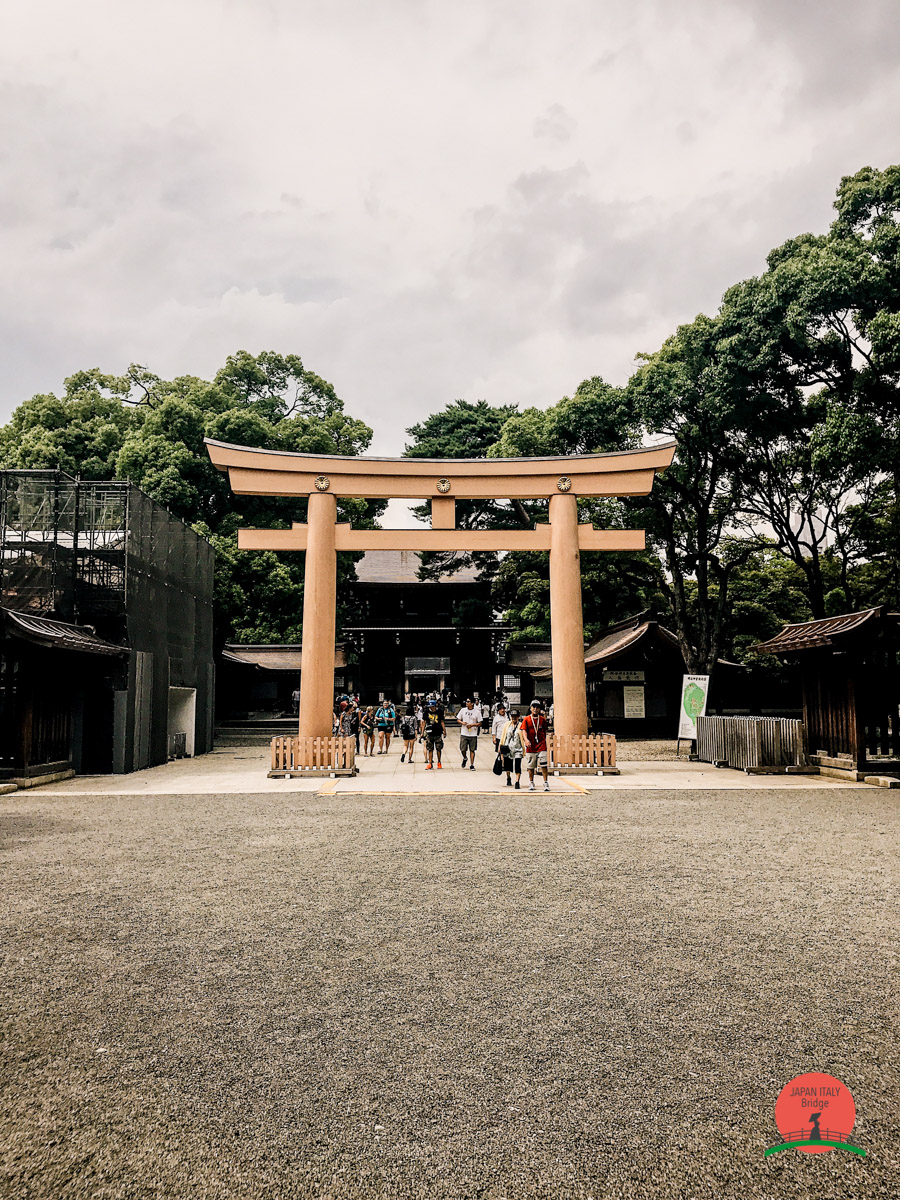
E’ incredibile come dopo aver passato la grande porta Torii, il rumoroso viavai di Tokyo sparisce e viene sostituito dai suoni tranquilli della foresta e dalle folte chiome arboree. Qui i visitatori del tempio possono prendere parte alle tipiche attività shintoise, come fare offerte nell’area principale, comprare porta fortuna e amuleti, o scrivere un vostro desiderio sulle famose tavolette ema. Non è raro infatti trovare persone di tutte le età che acquistano queste tavolette in legno e che esprimono il proprio desiderio scrivendolo proprio su questi supporti. Una volta espresso il vostro desiderio o augurio, gli ema vengono appesi su un supporto centrale nel tempio e successivamente recuperati dai preti che invieranno poi i messaggi ai Kami (dei).
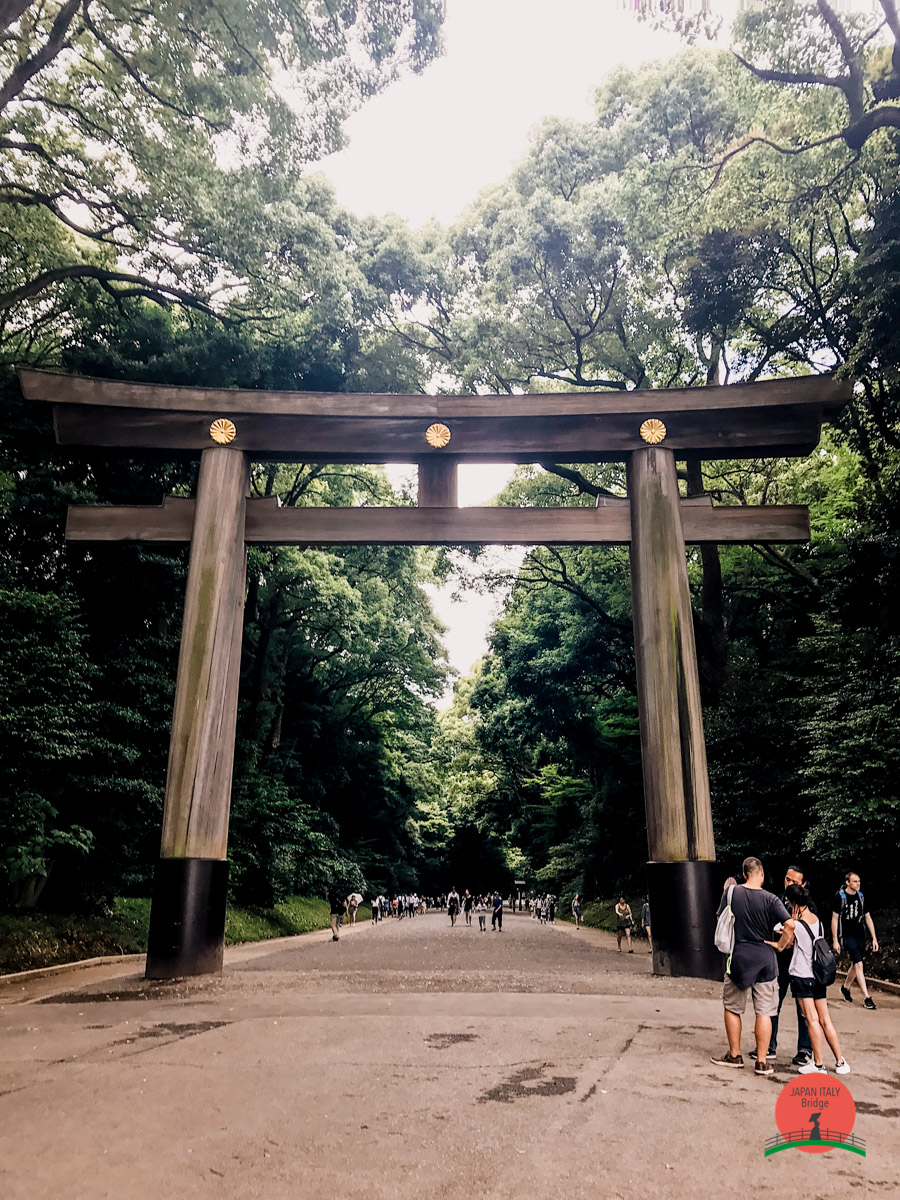
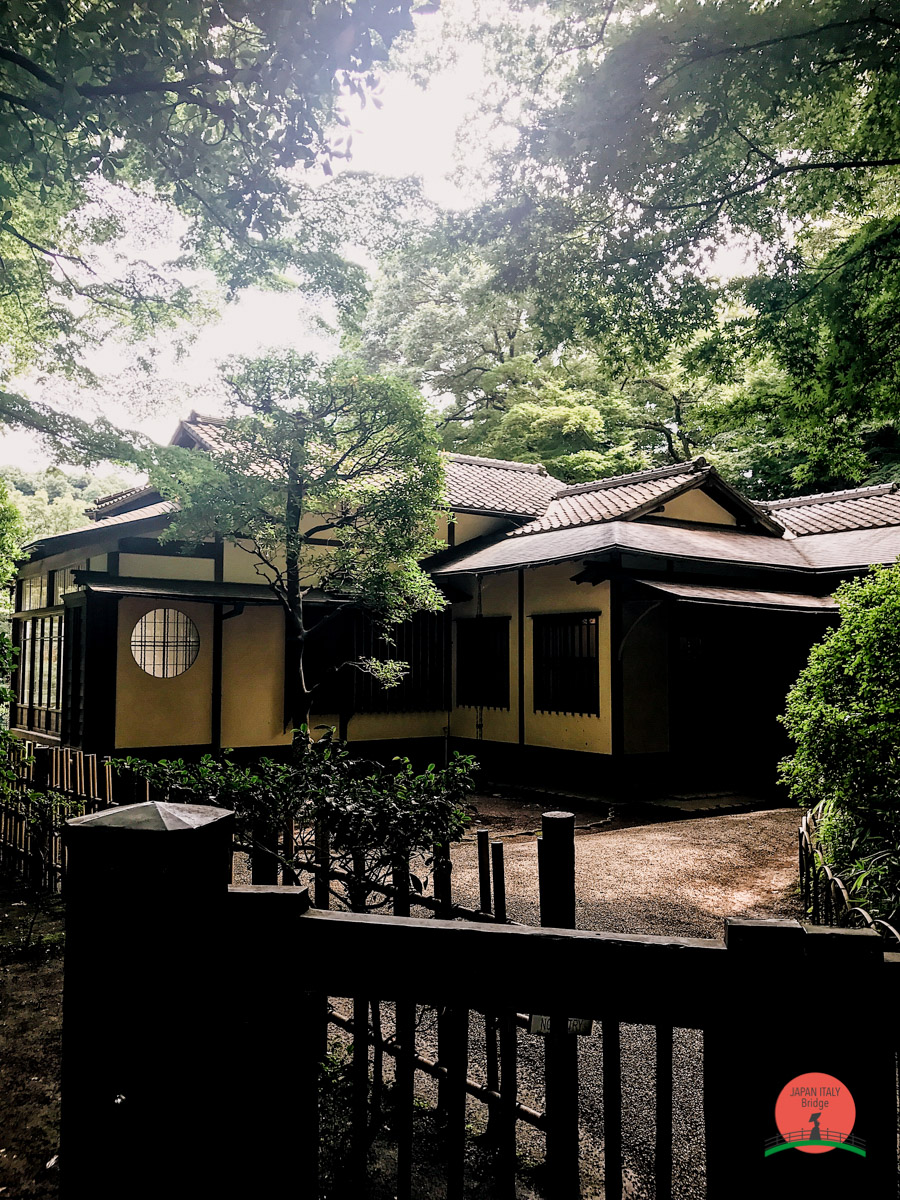
Il Meiji Jingu è uno dei templi più popolari del Giappone e proprio in questo periodo dell’anno, subito dopo l’Omisoka, accoglie regolarmente più di tre milioni di visitatori per l’Hatsumode, le prime preghiere dell’anno.
Nella parte più a nord delle terre legate al tempio, i visitatori possono trovare la casa dei tesori del Meiji Jingu, costruita un anno dopo che il tempio fu aperto. In questo luogo sono racchiusi molti oggetti personali legati all’Imperatore e all’imperatrice, inclusa la carrozza che ha accompagnato l’imperatore alla dichiarazione formale della costituzione Meiji nel 1889.


Una grande area della parte sud delle terre del tempio è occupata dai Giardini Interni, i quali richiedono un piccolo costo di entrata. Tuttavia questi giardini sono particolarmente popolari verso la metà di giugno per ammirare i fiori d’Iris in tutto il loro splendore, assieme alle famosissime gru giapponesi. E se avrete abbastanza pazienza, potrete avere l’occasione di vedere un piccolo stormo di questi fantastici volatili attraversare il grande lago, uno spettacolo unico e magico.
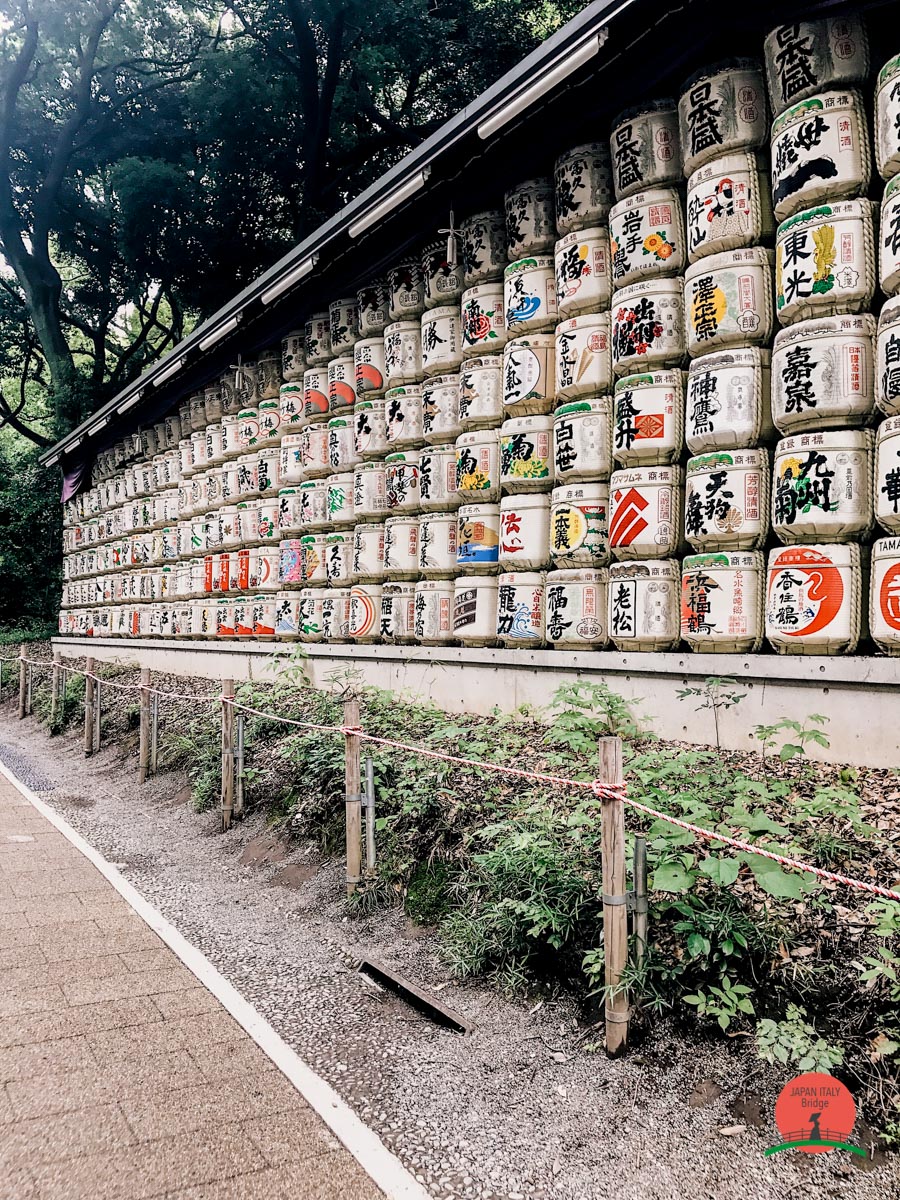
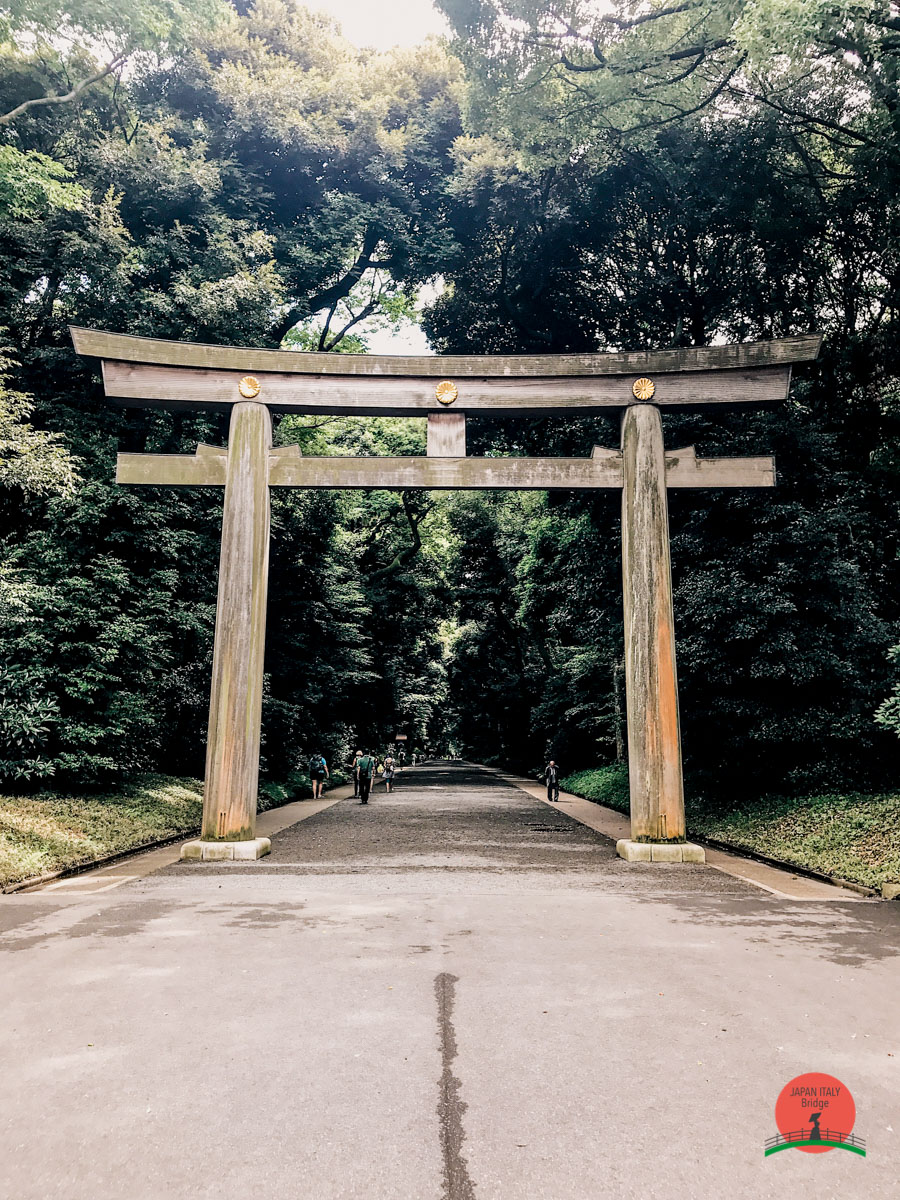
Inoltre, passeggiando lungo le vie interne del tempio e del parco, è possibile imbattersi in quello che io chiamo “muro del sake”, un muro composto da gigantesche botti di sake, un dono per l’imperatore da parte di tutte le sakagura del Giappone. Opposto a questo muro invece, è possibile trovare un muro di botti di vino, un dono per l’imperatore da parte di tutte le nazioni estere.
Inoltre, in preparazione del 100° anniversario nel 2020, lavori di ristrutturazione sono in atto per alcuni degli edifici del tempio, previsti fino all’ottobre 2019, quindi se pianificate di visitare Tokyo nel 2020 non potete assolutamente perdervi questa meta, fra una gara olimpica e l’altra!








